Advantage & Disadvantage of Management Accounting
VerifiedAdded on 2021/02/19
|21
|6035
|116
AI Summary
Contribute Materials
Your contribution can guide someone’s learning journey. Share your
documents today.
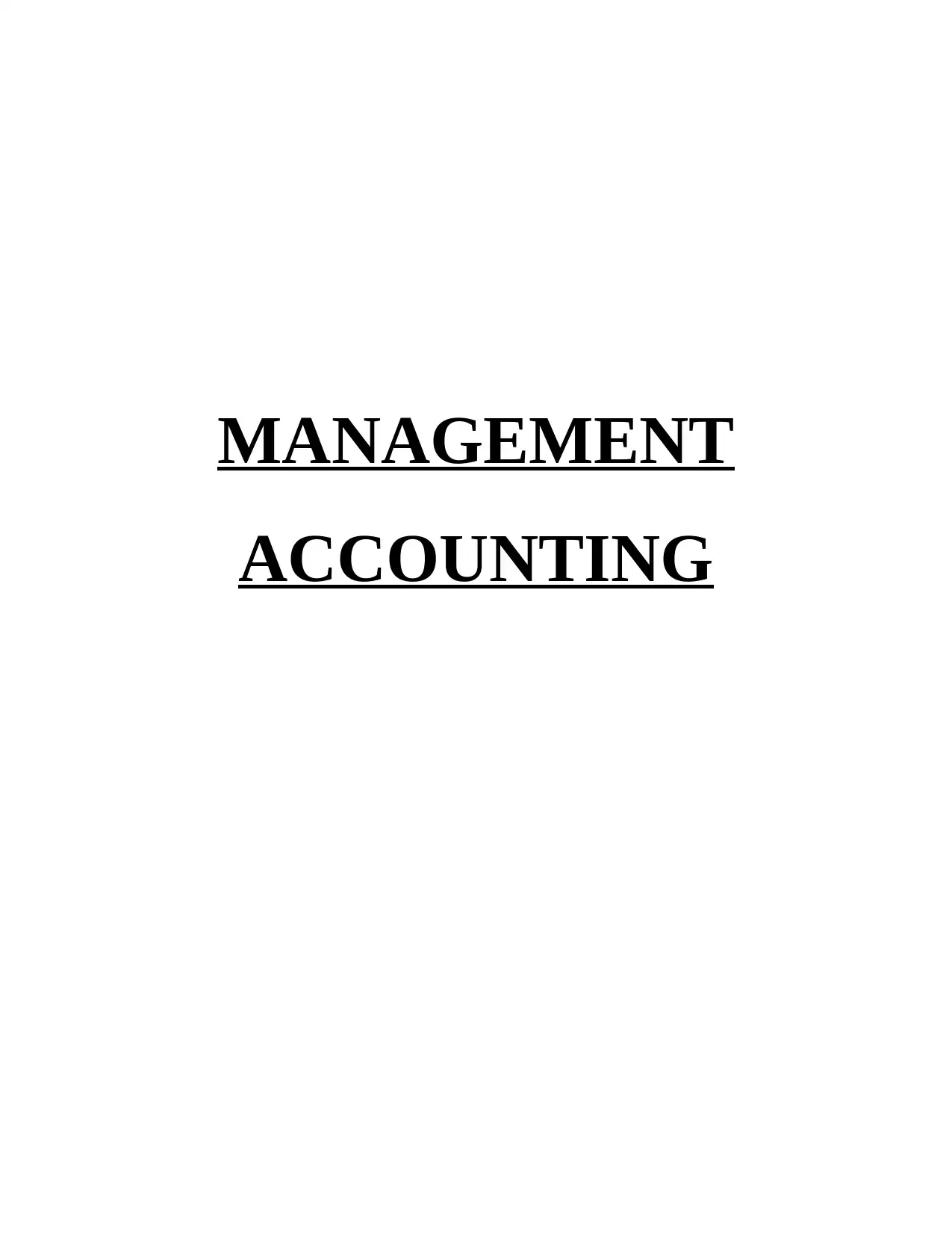
MANAGEMENT
ACCOUNTING
ACCOUNTING
Secure Best Marks with AI Grader
Need help grading? Try our AI Grader for instant feedback on your assignments.
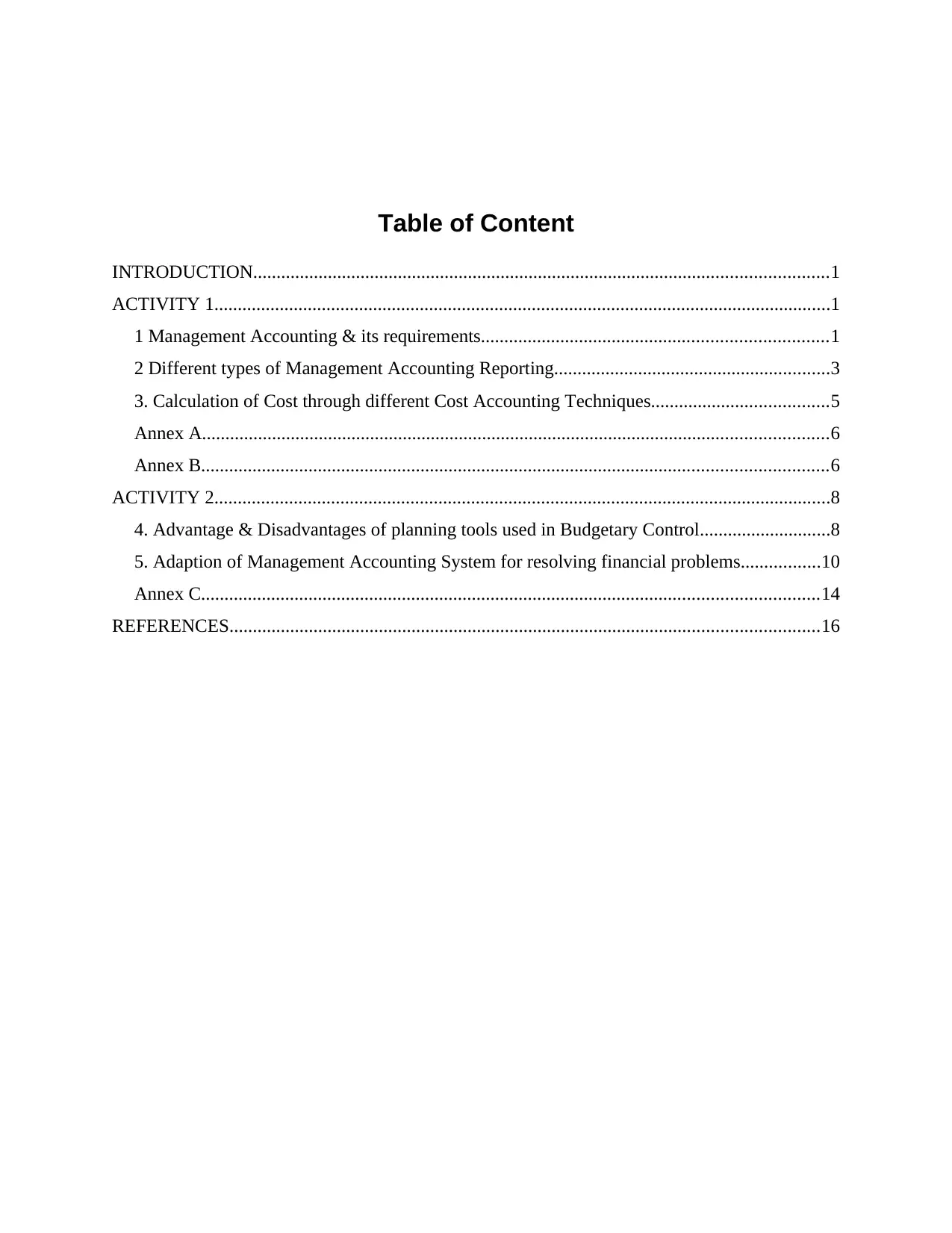
Table of Content
INTRODUCTION...........................................................................................................................1
ACTIVITY 1....................................................................................................................................1
1 Management Accounting & its requirements..........................................................................1
2 Different types of Management Accounting Reporting...........................................................3
3. Calculation of Cost through different Cost Accounting Techniques......................................5
Annex A......................................................................................................................................6
Annex B......................................................................................................................................6
ACTIVITY 2....................................................................................................................................8
4. Advantage & Disadvantages of planning tools used in Budgetary Control............................8
5. Adaption of Management Accounting System for resolving financial problems.................10
Annex C....................................................................................................................................14
REFERENCES..............................................................................................................................16
INTRODUCTION...........................................................................................................................1
ACTIVITY 1....................................................................................................................................1
1 Management Accounting & its requirements..........................................................................1
2 Different types of Management Accounting Reporting...........................................................3
3. Calculation of Cost through different Cost Accounting Techniques......................................5
Annex A......................................................................................................................................6
Annex B......................................................................................................................................6
ACTIVITY 2....................................................................................................................................8
4. Advantage & Disadvantages of planning tools used in Budgetary Control............................8
5. Adaption of Management Accounting System for resolving financial problems.................10
Annex C....................................................................................................................................14
REFERENCES..............................................................................................................................16
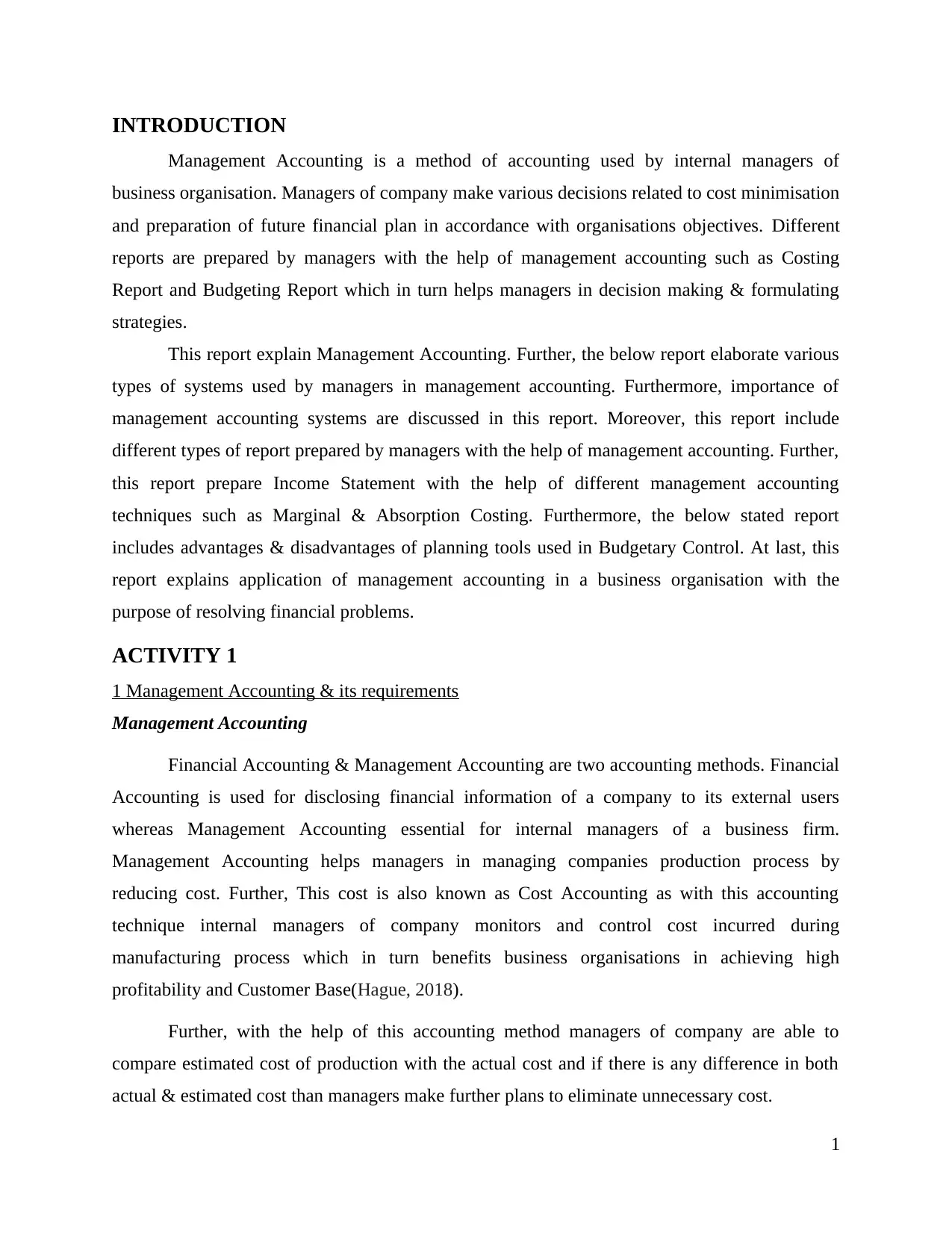
INTRODUCTION
Management Accounting is a method of accounting used by internal managers of
business organisation. Managers of company make various decisions related to cost minimisation
and preparation of future financial plan in accordance with organisations objectives. Different
reports are prepared by managers with the help of management accounting such as Costing
Report and Budgeting Report which in turn helps managers in decision making & formulating
strategies.
This report explain Management Accounting. Further, the below report elaborate various
types of systems used by managers in management accounting. Furthermore, importance of
management accounting systems are discussed in this report. Moreover, this report include
different types of report prepared by managers with the help of management accounting. Further,
this report prepare Income Statement with the help of different management accounting
techniques such as Marginal & Absorption Costing. Furthermore, the below stated report
includes advantages & disadvantages of planning tools used in Budgetary Control. At last, this
report explains application of management accounting in a business organisation with the
purpose of resolving financial problems.
ACTIVITY 1
1 Management Accounting & its requirements
Management Accounting
Financial Accounting & Management Accounting are two accounting methods. Financial
Accounting is used for disclosing financial information of a company to its external users
whereas Management Accounting essential for internal managers of a business firm.
Management Accounting helps managers in managing companies production process by
reducing cost. Further, This cost is also known as Cost Accounting as with this accounting
technique internal managers of company monitors and control cost incurred during
manufacturing process which in turn benefits business organisations in achieving high
profitability and Customer Base(Hague, 2018).
Further, with the help of this accounting method managers of company are able to
compare estimated cost of production with the actual cost and if there is any difference in both
actual & estimated cost than managers make further plans to eliminate unnecessary cost.
1
Management Accounting is a method of accounting used by internal managers of
business organisation. Managers of company make various decisions related to cost minimisation
and preparation of future financial plan in accordance with organisations objectives. Different
reports are prepared by managers with the help of management accounting such as Costing
Report and Budgeting Report which in turn helps managers in decision making & formulating
strategies.
This report explain Management Accounting. Further, the below report elaborate various
types of systems used by managers in management accounting. Furthermore, importance of
management accounting systems are discussed in this report. Moreover, this report include
different types of report prepared by managers with the help of management accounting. Further,
this report prepare Income Statement with the help of different management accounting
techniques such as Marginal & Absorption Costing. Furthermore, the below stated report
includes advantages & disadvantages of planning tools used in Budgetary Control. At last, this
report explains application of management accounting in a business organisation with the
purpose of resolving financial problems.
ACTIVITY 1
1 Management Accounting & its requirements
Management Accounting
Financial Accounting & Management Accounting are two accounting methods. Financial
Accounting is used for disclosing financial information of a company to its external users
whereas Management Accounting essential for internal managers of a business firm.
Management Accounting helps managers in managing companies production process by
reducing cost. Further, This cost is also known as Cost Accounting as with this accounting
technique internal managers of company monitors and control cost incurred during
manufacturing process which in turn benefits business organisations in achieving high
profitability and Customer Base(Hague, 2018).
Further, with the help of this accounting method managers of company are able to
compare estimated cost of production with the actual cost and if there is any difference in both
actual & estimated cost than managers make further plans to eliminate unnecessary cost.
1
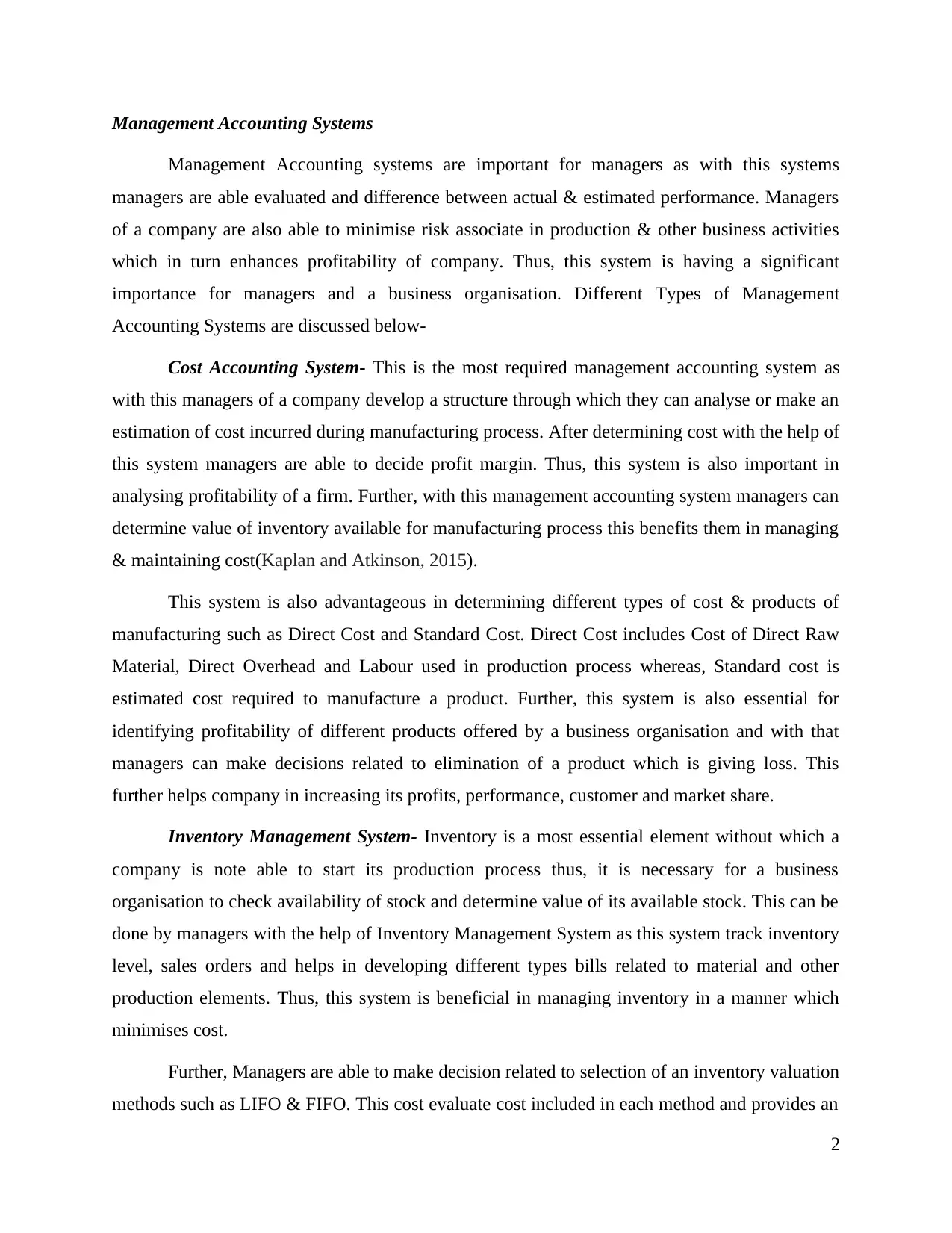
Management Accounting Systems
Management Accounting systems are important for managers as with this systems
managers are able evaluated and difference between actual & estimated performance. Managers
of a company are also able to minimise risk associate in production & other business activities
which in turn enhances profitability of company. Thus, this system is having a significant
importance for managers and a business organisation. Different Types of Management
Accounting Systems are discussed below-
Cost Accounting System- This is the most required management accounting system as
with this managers of a company develop a structure through which they can analyse or make an
estimation of cost incurred during manufacturing process. After determining cost with the help of
this system managers are able to decide profit margin. Thus, this system is also important in
analysing profitability of a firm. Further, with this management accounting system managers can
determine value of inventory available for manufacturing process this benefits them in managing
& maintaining cost(Kaplan and Atkinson, 2015).
This system is also advantageous in determining different types of cost & products of
manufacturing such as Direct Cost and Standard Cost. Direct Cost includes Cost of Direct Raw
Material, Direct Overhead and Labour used in production process whereas, Standard cost is
estimated cost required to manufacture a product. Further, this system is also essential for
identifying profitability of different products offered by a business organisation and with that
managers can make decisions related to elimination of a product which is giving loss. This
further helps company in increasing its profits, performance, customer and market share.
Inventory Management System- Inventory is a most essential element without which a
company is note able to start its production process thus, it is necessary for a business
organisation to check availability of stock and determine value of its available stock. This can be
done by managers with the help of Inventory Management System as this system track inventory
level, sales orders and helps in developing different types bills related to material and other
production elements. Thus, this system is beneficial in managing inventory in a manner which
minimises cost.
Further, Managers are able to make decision related to selection of an inventory valuation
methods such as LIFO & FIFO. This cost evaluate cost included in each method and provides an
2
Management Accounting systems are important for managers as with this systems
managers are able evaluated and difference between actual & estimated performance. Managers
of a company are also able to minimise risk associate in production & other business activities
which in turn enhances profitability of company. Thus, this system is having a significant
importance for managers and a business organisation. Different Types of Management
Accounting Systems are discussed below-
Cost Accounting System- This is the most required management accounting system as
with this managers of a company develop a structure through which they can analyse or make an
estimation of cost incurred during manufacturing process. After determining cost with the help of
this system managers are able to decide profit margin. Thus, this system is also important in
analysing profitability of a firm. Further, with this management accounting system managers can
determine value of inventory available for manufacturing process this benefits them in managing
& maintaining cost(Kaplan and Atkinson, 2015).
This system is also advantageous in determining different types of cost & products of
manufacturing such as Direct Cost and Standard Cost. Direct Cost includes Cost of Direct Raw
Material, Direct Overhead and Labour used in production process whereas, Standard cost is
estimated cost required to manufacture a product. Further, this system is also essential for
identifying profitability of different products offered by a business organisation and with that
managers can make decisions related to elimination of a product which is giving loss. This
further helps company in increasing its profits, performance, customer and market share.
Inventory Management System- Inventory is a most essential element without which a
company is note able to start its production process thus, it is necessary for a business
organisation to check availability of stock and determine value of its available stock. This can be
done by managers with the help of Inventory Management System as this system track inventory
level, sales orders and helps in developing different types bills related to material and other
production elements. Thus, this system is beneficial in managing inventory in a manner which
minimises cost.
Further, Managers are able to make decision related to selection of an inventory valuation
methods such as LIFO & FIFO. This cost evaluate cost included in each method and provides an
2
Secure Best Marks with AI Grader
Need help grading? Try our AI Grader for instant feedback on your assignments.
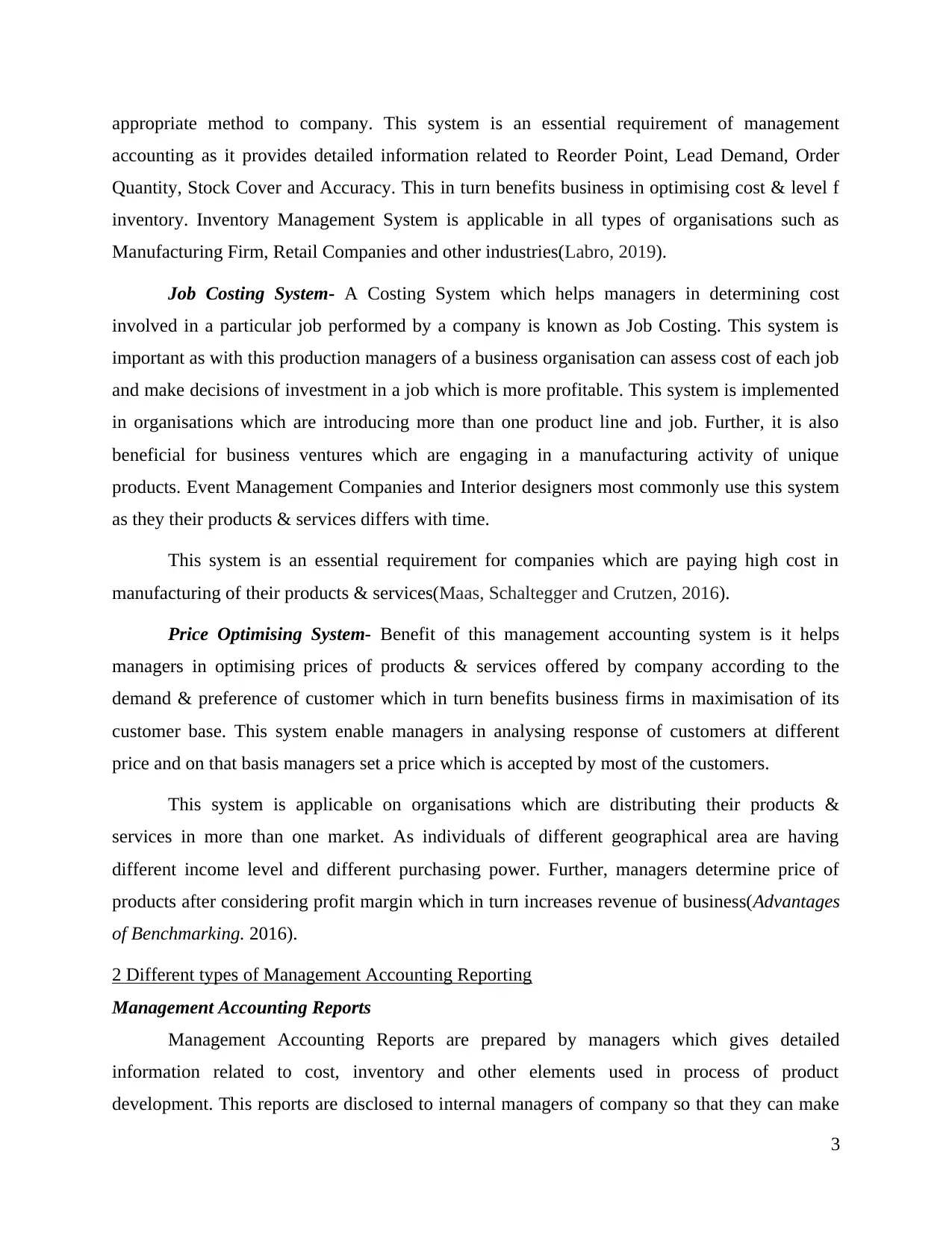
appropriate method to company. This system is an essential requirement of management
accounting as it provides detailed information related to Reorder Point, Lead Demand, Order
Quantity, Stock Cover and Accuracy. This in turn benefits business in optimising cost & level f
inventory. Inventory Management System is applicable in all types of organisations such as
Manufacturing Firm, Retail Companies and other industries(Labro, 2019).
Job Costing System- A Costing System which helps managers in determining cost
involved in a particular job performed by a company is known as Job Costing. This system is
important as with this production managers of a business organisation can assess cost of each job
and make decisions of investment in a job which is more profitable. This system is implemented
in organisations which are introducing more than one product line and job. Further, it is also
beneficial for business ventures which are engaging in a manufacturing activity of unique
products. Event Management Companies and Interior designers most commonly use this system
as they their products & services differs with time.
This system is an essential requirement for companies which are paying high cost in
manufacturing of their products & services(Maas, Schaltegger and Crutzen, 2016).
Price Optimising System- Benefit of this management accounting system is it helps
managers in optimising prices of products & services offered by company according to the
demand & preference of customer which in turn benefits business firms in maximisation of its
customer base. This system enable managers in analysing response of customers at different
price and on that basis managers set a price which is accepted by most of the customers.
This system is applicable on organisations which are distributing their products &
services in more than one market. As individuals of different geographical area are having
different income level and different purchasing power. Further, managers determine price of
products after considering profit margin which in turn increases revenue of business(Advantages
of Benchmarking. 2016).
2 Different types of Management Accounting Reporting
Management Accounting Reports
Management Accounting Reports are prepared by managers which gives detailed
information related to cost, inventory and other elements used in process of product
development. This reports are disclosed to internal managers of company so that they can make
3
accounting as it provides detailed information related to Reorder Point, Lead Demand, Order
Quantity, Stock Cover and Accuracy. This in turn benefits business in optimising cost & level f
inventory. Inventory Management System is applicable in all types of organisations such as
Manufacturing Firm, Retail Companies and other industries(Labro, 2019).
Job Costing System- A Costing System which helps managers in determining cost
involved in a particular job performed by a company is known as Job Costing. This system is
important as with this production managers of a business organisation can assess cost of each job
and make decisions of investment in a job which is more profitable. This system is implemented
in organisations which are introducing more than one product line and job. Further, it is also
beneficial for business ventures which are engaging in a manufacturing activity of unique
products. Event Management Companies and Interior designers most commonly use this system
as they their products & services differs with time.
This system is an essential requirement for companies which are paying high cost in
manufacturing of their products & services(Maas, Schaltegger and Crutzen, 2016).
Price Optimising System- Benefit of this management accounting system is it helps
managers in optimising prices of products & services offered by company according to the
demand & preference of customer which in turn benefits business firms in maximisation of its
customer base. This system enable managers in analysing response of customers at different
price and on that basis managers set a price which is accepted by most of the customers.
This system is applicable on organisations which are distributing their products &
services in more than one market. As individuals of different geographical area are having
different income level and different purchasing power. Further, managers determine price of
products after considering profit margin which in turn increases revenue of business(Advantages
of Benchmarking. 2016).
2 Different types of Management Accounting Reporting
Management Accounting Reports
Management Accounting Reports are prepared by managers which gives detailed
information related to cost, inventory and other elements used in process of product
development. This reports are disclosed to internal managers of company so that they can make
3
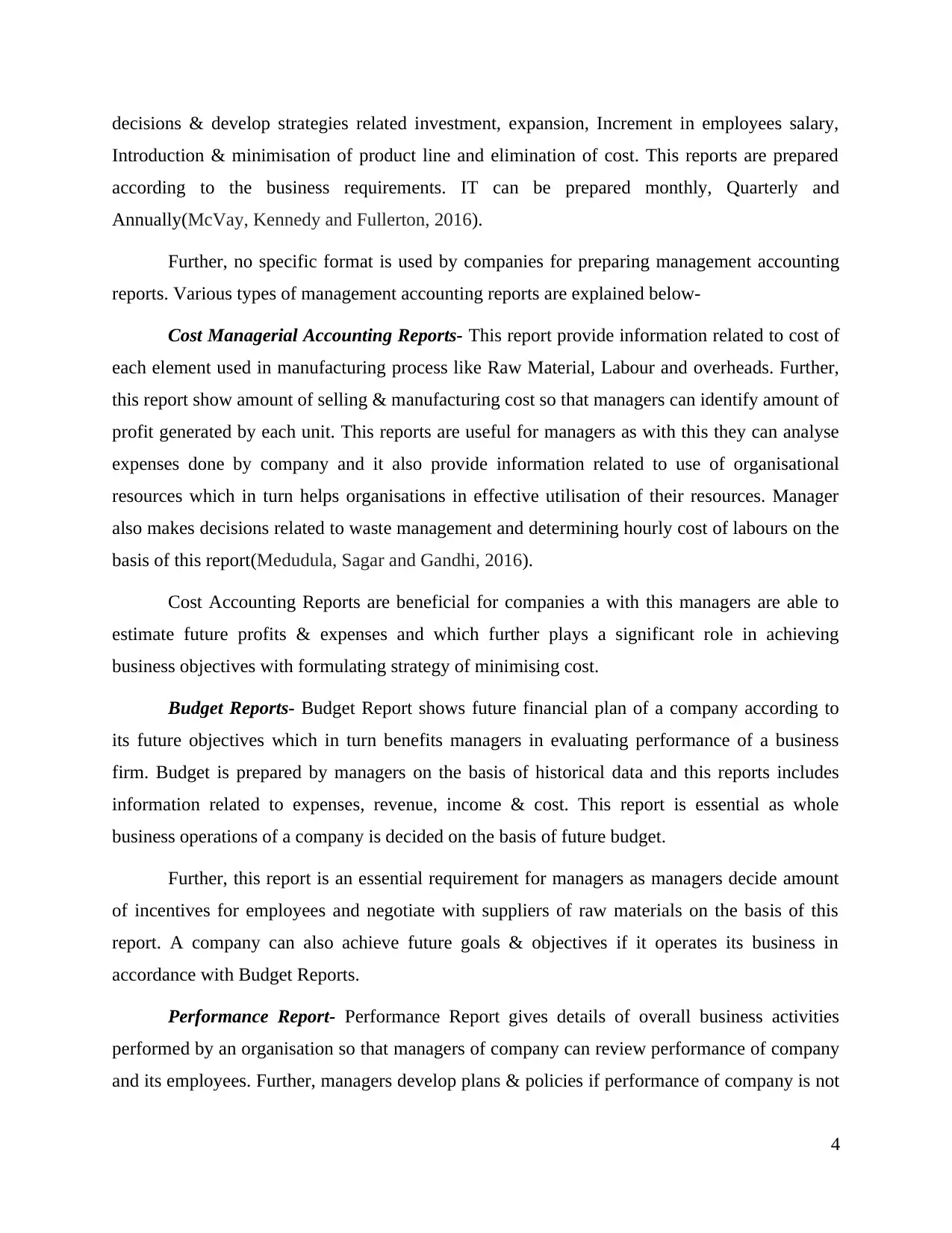
decisions & develop strategies related investment, expansion, Increment in employees salary,
Introduction & minimisation of product line and elimination of cost. This reports are prepared
according to the business requirements. IT can be prepared monthly, Quarterly and
Annually(McVay, Kennedy and Fullerton, 2016).
Further, no specific format is used by companies for preparing management accounting
reports. Various types of management accounting reports are explained below-
Cost Managerial Accounting Reports- This report provide information related to cost of
each element used in manufacturing process like Raw Material, Labour and overheads. Further,
this report show amount of selling & manufacturing cost so that managers can identify amount of
profit generated by each unit. This reports are useful for managers as with this they can analyse
expenses done by company and it also provide information related to use of organisational
resources which in turn helps organisations in effective utilisation of their resources. Manager
also makes decisions related to waste management and determining hourly cost of labours on the
basis of this report(Medudula, Sagar and Gandhi, 2016).
Cost Accounting Reports are beneficial for companies a with this managers are able to
estimate future profits & expenses and which further plays a significant role in achieving
business objectives with formulating strategy of minimising cost.
Budget Reports- Budget Report shows future financial plan of a company according to
its future objectives which in turn benefits managers in evaluating performance of a business
firm. Budget is prepared by managers on the basis of historical data and this reports includes
information related to expenses, revenue, income & cost. This report is essential as whole
business operations of a company is decided on the basis of future budget.
Further, this report is an essential requirement for managers as managers decide amount
of incentives for employees and negotiate with suppliers of raw materials on the basis of this
report. A company can also achieve future goals & objectives if it operates its business in
accordance with Budget Reports.
Performance Report- Performance Report gives details of overall business activities
performed by an organisation so that managers of company can review performance of company
and its employees. Further, managers develop plans & policies if performance of company is not
4
Introduction & minimisation of product line and elimination of cost. This reports are prepared
according to the business requirements. IT can be prepared monthly, Quarterly and
Annually(McVay, Kennedy and Fullerton, 2016).
Further, no specific format is used by companies for preparing management accounting
reports. Various types of management accounting reports are explained below-
Cost Managerial Accounting Reports- This report provide information related to cost of
each element used in manufacturing process like Raw Material, Labour and overheads. Further,
this report show amount of selling & manufacturing cost so that managers can identify amount of
profit generated by each unit. This reports are useful for managers as with this they can analyse
expenses done by company and it also provide information related to use of organisational
resources which in turn helps organisations in effective utilisation of their resources. Manager
also makes decisions related to waste management and determining hourly cost of labours on the
basis of this report(Medudula, Sagar and Gandhi, 2016).
Cost Accounting Reports are beneficial for companies a with this managers are able to
estimate future profits & expenses and which further plays a significant role in achieving
business objectives with formulating strategy of minimising cost.
Budget Reports- Budget Report shows future financial plan of a company according to
its future objectives which in turn benefits managers in evaluating performance of a business
firm. Budget is prepared by managers on the basis of historical data and this reports includes
information related to expenses, revenue, income & cost. This report is essential as whole
business operations of a company is decided on the basis of future budget.
Further, this report is an essential requirement for managers as managers decide amount
of incentives for employees and negotiate with suppliers of raw materials on the basis of this
report. A company can also achieve future goals & objectives if it operates its business in
accordance with Budget Reports.
Performance Report- Performance Report gives details of overall business activities
performed by an organisation so that managers of company can review performance of company
and its employees. Further, managers develop plans & policies if performance of company is not
4
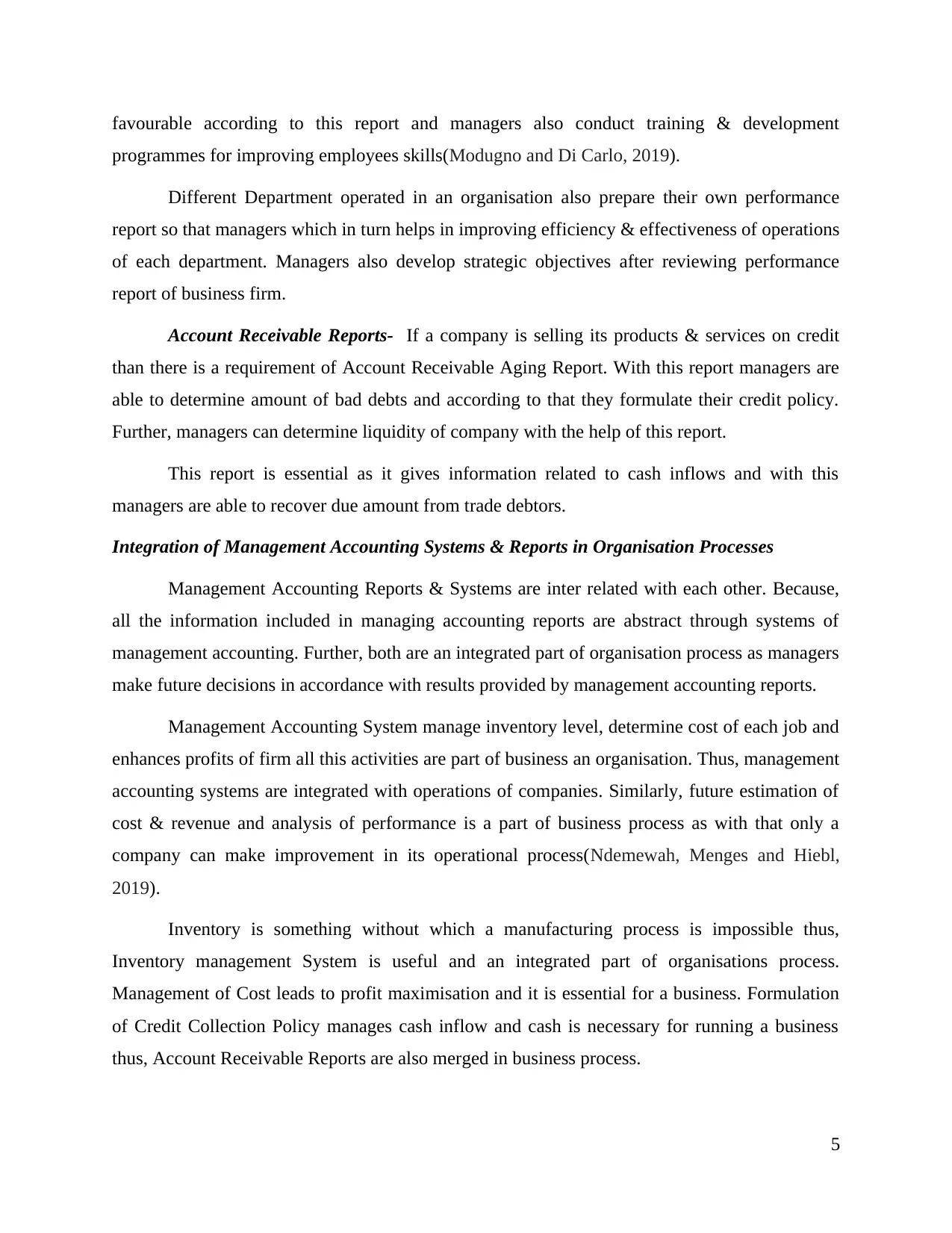
favourable according to this report and managers also conduct training & development
programmes for improving employees skills(Modugno and Di Carlo, 2019).
Different Department operated in an organisation also prepare their own performance
report so that managers which in turn helps in improving efficiency & effectiveness of operations
of each department. Managers also develop strategic objectives after reviewing performance
report of business firm.
Account Receivable Reports- If a company is selling its products & services on credit
than there is a requirement of Account Receivable Aging Report. With this report managers are
able to determine amount of bad debts and according to that they formulate their credit policy.
Further, managers can determine liquidity of company with the help of this report.
This report is essential as it gives information related to cash inflows and with this
managers are able to recover due amount from trade debtors.
Integration of Management Accounting Systems & Reports in Organisation Processes
Management Accounting Reports & Systems are inter related with each other. Because,
all the information included in managing accounting reports are abstract through systems of
management accounting. Further, both are an integrated part of organisation process as managers
make future decisions in accordance with results provided by management accounting reports.
Management Accounting System manage inventory level, determine cost of each job and
enhances profits of firm all this activities are part of business an organisation. Thus, management
accounting systems are integrated with operations of companies. Similarly, future estimation of
cost & revenue and analysis of performance is a part of business process as with that only a
company can make improvement in its operational process(Ndemewah, Menges and Hiebl,
2019).
Inventory is something without which a manufacturing process is impossible thus,
Inventory management System is useful and an integrated part of organisations process.
Management of Cost leads to profit maximisation and it is essential for a business. Formulation
of Credit Collection Policy manages cash inflow and cash is necessary for running a business
thus, Account Receivable Reports are also merged in business process.
5
programmes for improving employees skills(Modugno and Di Carlo, 2019).
Different Department operated in an organisation also prepare their own performance
report so that managers which in turn helps in improving efficiency & effectiveness of operations
of each department. Managers also develop strategic objectives after reviewing performance
report of business firm.
Account Receivable Reports- If a company is selling its products & services on credit
than there is a requirement of Account Receivable Aging Report. With this report managers are
able to determine amount of bad debts and according to that they formulate their credit policy.
Further, managers can determine liquidity of company with the help of this report.
This report is essential as it gives information related to cash inflows and with this
managers are able to recover due amount from trade debtors.
Integration of Management Accounting Systems & Reports in Organisation Processes
Management Accounting Reports & Systems are inter related with each other. Because,
all the information included in managing accounting reports are abstract through systems of
management accounting. Further, both are an integrated part of organisation process as managers
make future decisions in accordance with results provided by management accounting reports.
Management Accounting System manage inventory level, determine cost of each job and
enhances profits of firm all this activities are part of business an organisation. Thus, management
accounting systems are integrated with operations of companies. Similarly, future estimation of
cost & revenue and analysis of performance is a part of business process as with that only a
company can make improvement in its operational process(Ndemewah, Menges and Hiebl,
2019).
Inventory is something without which a manufacturing process is impossible thus,
Inventory management System is useful and an integrated part of organisations process.
Management of Cost leads to profit maximisation and it is essential for a business. Formulation
of Credit Collection Policy manages cash inflow and cash is necessary for running a business
thus, Account Receivable Reports are also merged in business process.
5
Paraphrase This Document
Need a fresh take? Get an instant paraphrase of this document with our AI Paraphraser
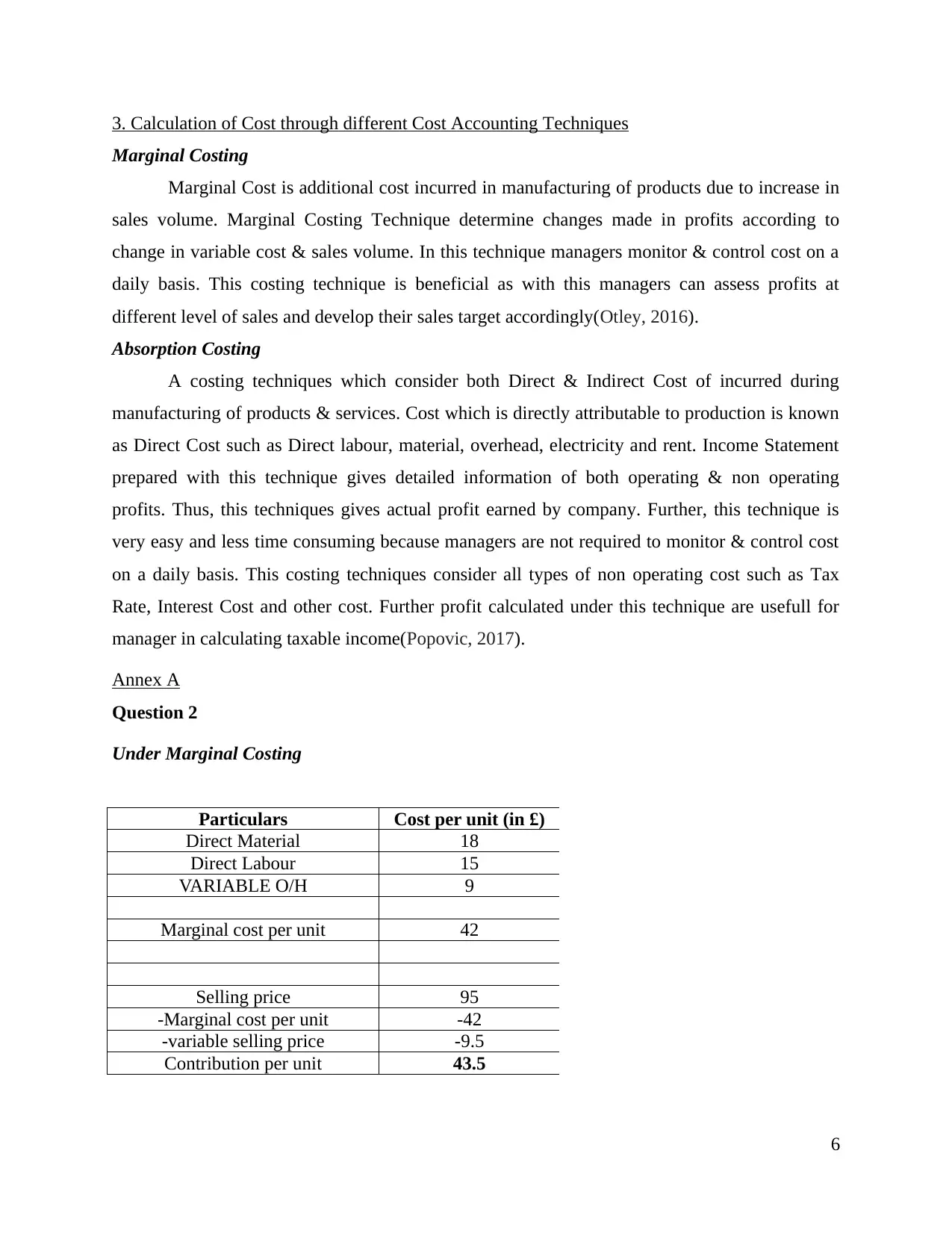
3. Calculation of Cost through different Cost Accounting Techniques
Marginal Costing
Marginal Cost is additional cost incurred in manufacturing of products due to increase in
sales volume. Marginal Costing Technique determine changes made in profits according to
change in variable cost & sales volume. In this technique managers monitor & control cost on a
daily basis. This costing technique is beneficial as with this managers can assess profits at
different level of sales and develop their sales target accordingly(Otley, 2016).
Absorption Costing
A costing techniques which consider both Direct & Indirect Cost of incurred during
manufacturing of products & services. Cost which is directly attributable to production is known
as Direct Cost such as Direct labour, material, overhead, electricity and rent. Income Statement
prepared with this technique gives detailed information of both operating & non operating
profits. Thus, this techniques gives actual profit earned by company. Further, this technique is
very easy and less time consuming because managers are not required to monitor & control cost
on a daily basis. This costing techniques consider all types of non operating cost such as Tax
Rate, Interest Cost and other cost. Further profit calculated under this technique are usefull for
manager in calculating taxable income(Popovic, 2017).
Annex A
Question 2
Under Marginal Costing
Particulars Cost per unit (in £)
Direct Material 18
Direct Labour 15
VARIABLE O/H 9
Marginal cost per unit 42
Selling price 95
-Marginal cost per unit -42
-variable selling price -9.5
Contribution per unit 43.5
6
Marginal Costing
Marginal Cost is additional cost incurred in manufacturing of products due to increase in
sales volume. Marginal Costing Technique determine changes made in profits according to
change in variable cost & sales volume. In this technique managers monitor & control cost on a
daily basis. This costing technique is beneficial as with this managers can assess profits at
different level of sales and develop their sales target accordingly(Otley, 2016).
Absorption Costing
A costing techniques which consider both Direct & Indirect Cost of incurred during
manufacturing of products & services. Cost which is directly attributable to production is known
as Direct Cost such as Direct labour, material, overhead, electricity and rent. Income Statement
prepared with this technique gives detailed information of both operating & non operating
profits. Thus, this techniques gives actual profit earned by company. Further, this technique is
very easy and less time consuming because managers are not required to monitor & control cost
on a daily basis. This costing techniques consider all types of non operating cost such as Tax
Rate, Interest Cost and other cost. Further profit calculated under this technique are usefull for
manager in calculating taxable income(Popovic, 2017).
Annex A
Question 2
Under Marginal Costing
Particulars Cost per unit (in £)
Direct Material 18
Direct Labour 15
VARIABLE O/H 9
Marginal cost per unit 42
Selling price 95
-Marginal cost per unit -42
-variable selling price -9.5
Contribution per unit 43.5
6
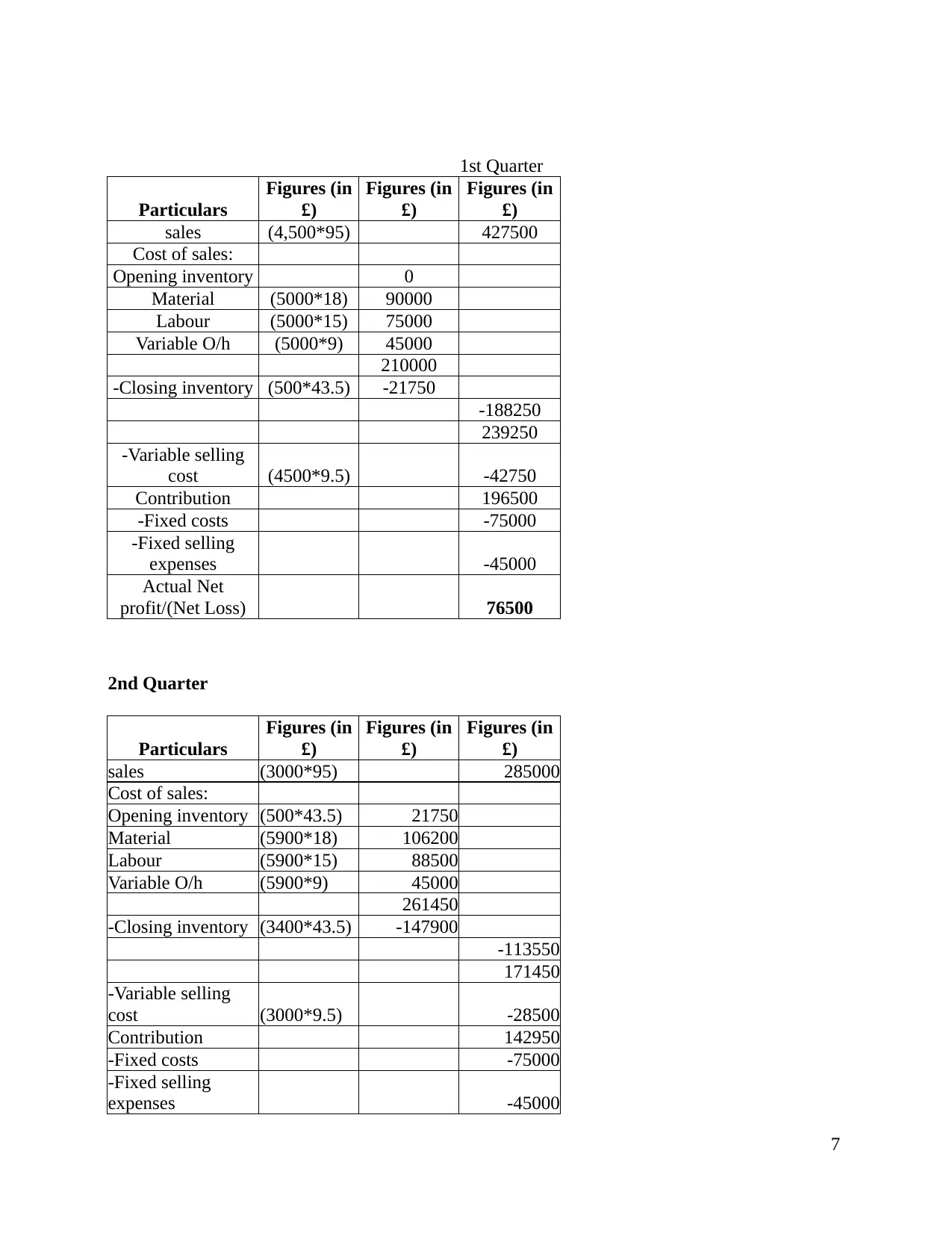
1st Quarter
Particulars
Figures (in
£)
Figures (in
£)
Figures (in
£)
sales (4,500*95) 427500
Cost of sales:
Opening inventory 0
Material (5000*18) 90000
Labour (5000*15) 75000
Variable O/h (5000*9) 45000
210000
-Closing inventory (500*43.5) -21750
-188250
239250
-Variable selling
cost (4500*9.5) -42750
Contribution 196500
-Fixed costs -75000
-Fixed selling
expenses -45000
Actual Net
profit/(Net Loss) 76500
2nd Quarter
Particulars
Figures (in
£)
Figures (in
£)
Figures (in
£)
sales (3000*95) 285000
Cost of sales:
Opening inventory (500*43.5) 21750
Material (5900*18) 106200
Labour (5900*15) 88500
Variable O/h (5900*9) 45000
261450
-Closing inventory (3400*43.5) -147900
-113550
171450
-Variable selling
cost (3000*9.5) -28500
Contribution 142950
-Fixed costs -75000
-Fixed selling
expenses -45000
7
Particulars
Figures (in
£)
Figures (in
£)
Figures (in
£)
sales (4,500*95) 427500
Cost of sales:
Opening inventory 0
Material (5000*18) 90000
Labour (5000*15) 75000
Variable O/h (5000*9) 45000
210000
-Closing inventory (500*43.5) -21750
-188250
239250
-Variable selling
cost (4500*9.5) -42750
Contribution 196500
-Fixed costs -75000
-Fixed selling
expenses -45000
Actual Net
profit/(Net Loss) 76500
2nd Quarter
Particulars
Figures (in
£)
Figures (in
£)
Figures (in
£)
sales (3000*95) 285000
Cost of sales:
Opening inventory (500*43.5) 21750
Material (5900*18) 106200
Labour (5900*15) 88500
Variable O/h (5900*9) 45000
261450
-Closing inventory (3400*43.5) -147900
-113550
171450
-Variable selling
cost (3000*9.5) -28500
Contribution 142950
-Fixed costs -75000
-Fixed selling
expenses -45000
7
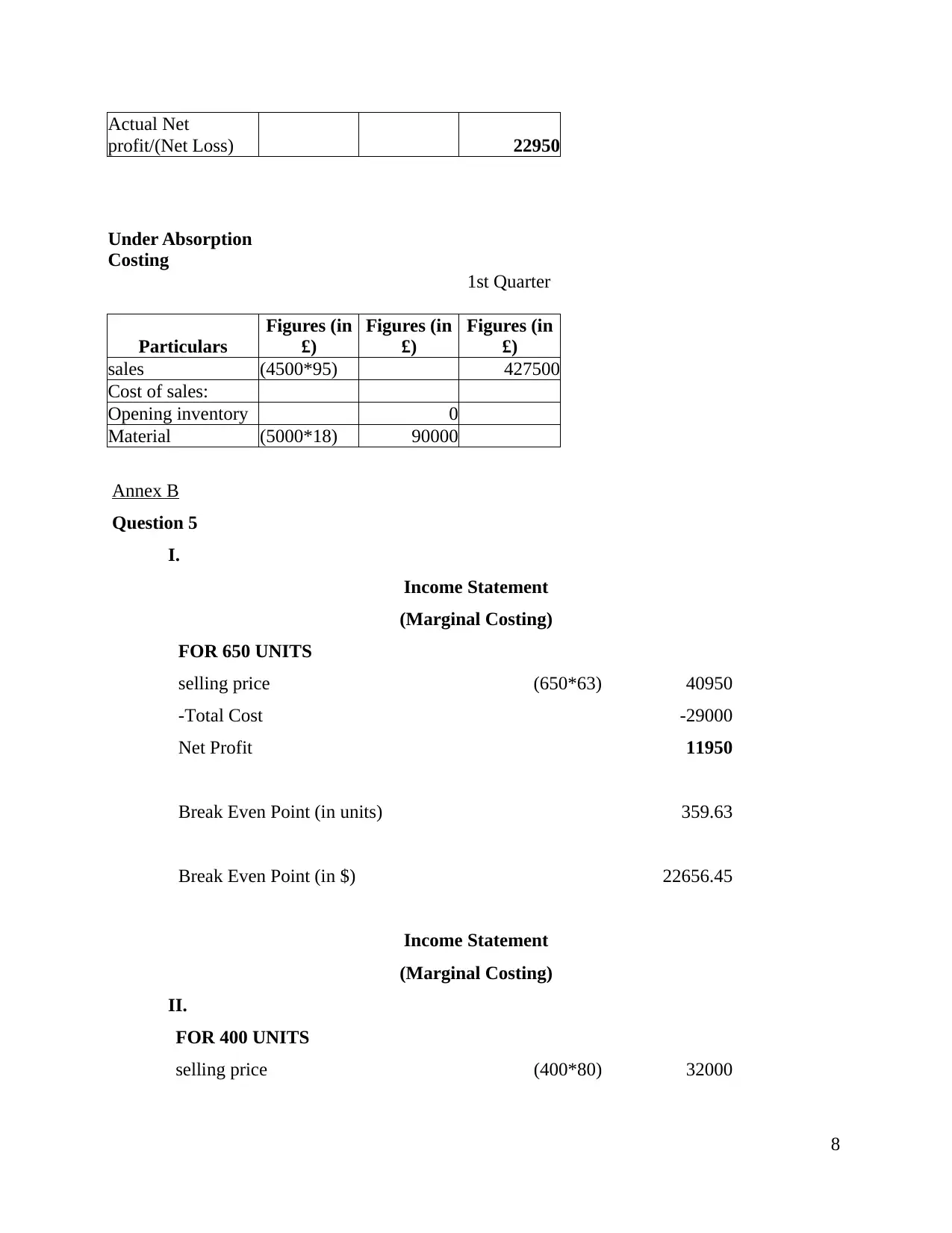
Actual Net
profit/(Net Loss) 22950
Under Absorption
Costing
1st Quarter
Particulars
Figures (in
£)
Figures (in
£)
Figures (in
£)
sales (4500*95) 427500
Cost of sales:
Opening inventory 0
Material (5000*18) 90000
Annex B
Question 5
I.
Income Statement
(Marginal Costing)
FOR 650 UNITS
selling price (650*63) 40950
-Total Cost -29000
Net Profit 11950
Break Even Point (in units) 359.63
Break Even Point (in $) 22656.45
Income Statement
(Marginal Costing)
II.
FOR 400 UNITS
selling price (400*80) 32000
8
profit/(Net Loss) 22950
Under Absorption
Costing
1st Quarter
Particulars
Figures (in
£)
Figures (in
£)
Figures (in
£)
sales (4500*95) 427500
Cost of sales:
Opening inventory 0
Material (5000*18) 90000
Annex B
Question 5
I.
Income Statement
(Marginal Costing)
FOR 650 UNITS
selling price (650*63) 40950
-Total Cost -29000
Net Profit 11950
Break Even Point (in units) 359.63
Break Even Point (in $) 22656.45
Income Statement
(Marginal Costing)
II.
FOR 400 UNITS
selling price (400*80) 32000
8
Secure Best Marks with AI Grader
Need help grading? Try our AI Grader for instant feedback on your assignments.
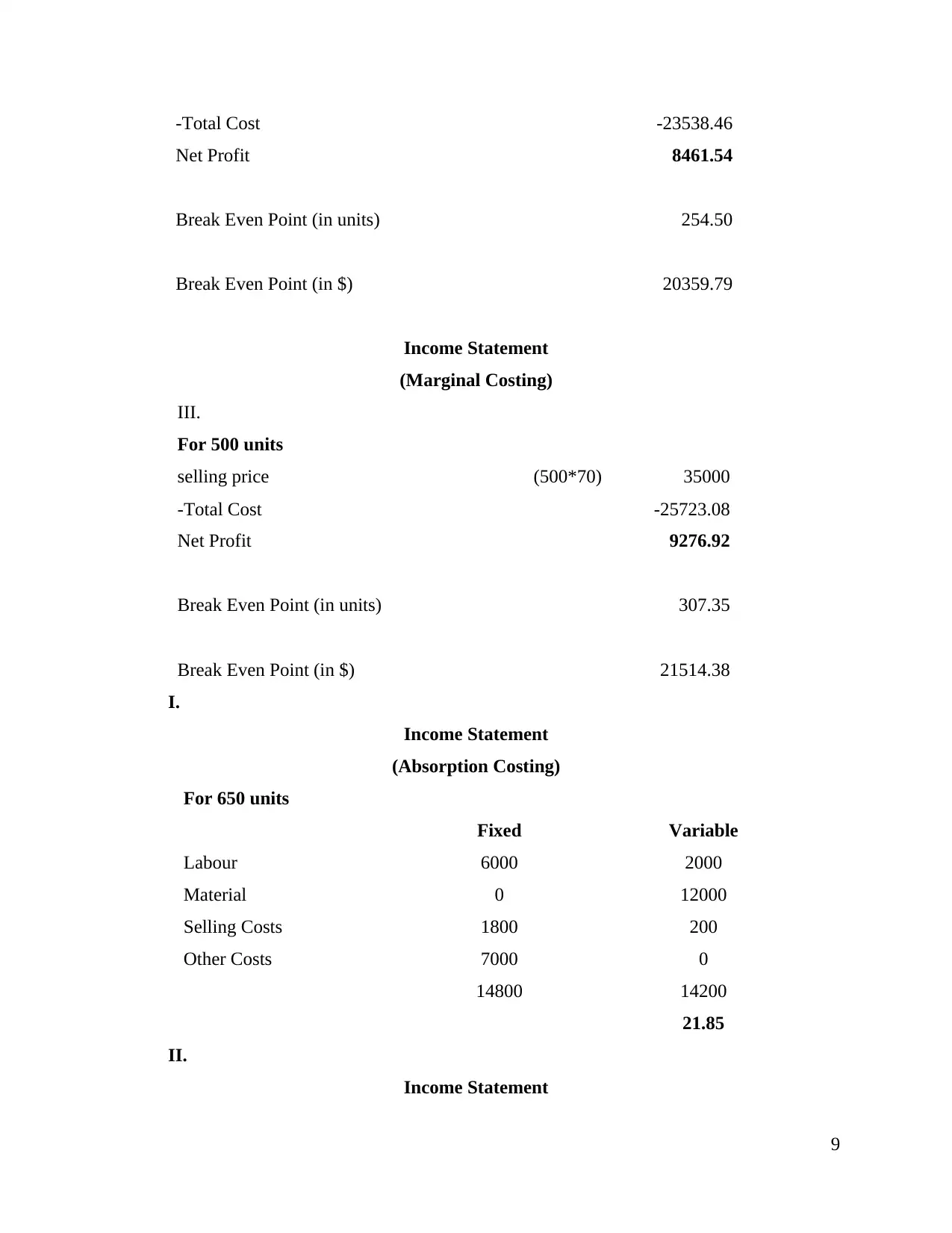
-Total Cost -23538.46
Net Profit 8461.54
Break Even Point (in units) 254.50
Break Even Point (in $) 20359.79
Income Statement
(Marginal Costing)
III.
For 500 units
selling price (500*70) 35000
-Total Cost -25723.08
Net Profit 9276.92
Break Even Point (in units) 307.35
Break Even Point (in $) 21514.38
I.
Income Statement
(Absorption Costing)
For 650 units
Fixed Variable
Labour 6000 2000
Material 0 12000
Selling Costs 1800 200
Other Costs 7000 0
14800 14200
21.85
II.
Income Statement
9
Net Profit 8461.54
Break Even Point (in units) 254.50
Break Even Point (in $) 20359.79
Income Statement
(Marginal Costing)
III.
For 500 units
selling price (500*70) 35000
-Total Cost -25723.08
Net Profit 9276.92
Break Even Point (in units) 307.35
Break Even Point (in $) 21514.38
I.
Income Statement
(Absorption Costing)
For 650 units
Fixed Variable
Labour 6000 2000
Material 0 12000
Selling Costs 1800 200
Other Costs 7000 0
14800 14200
21.85
II.
Income Statement
9
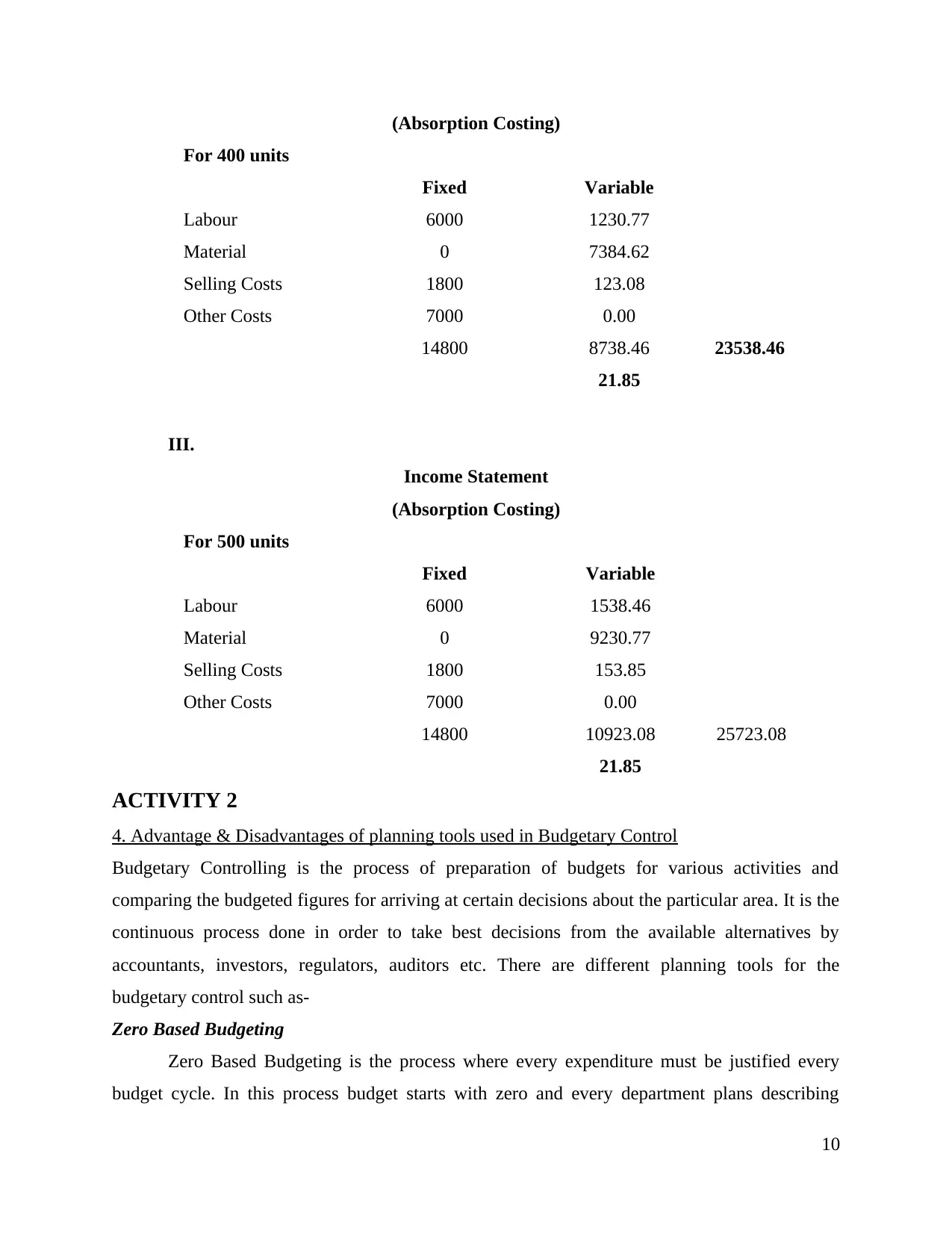
(Absorption Costing)
For 400 units
Fixed Variable
Labour 6000 1230.77
Material 0 7384.62
Selling Costs 1800 123.08
Other Costs 7000 0.00
14800 8738.46 23538.46
21.85
III.
Income Statement
(Absorption Costing)
For 500 units
Fixed Variable
Labour 6000 1538.46
Material 0 9230.77
Selling Costs 1800 153.85
Other Costs 7000 0.00
14800 10923.08 25723.08
21.85
ACTIVITY 2
4. Advantage & Disadvantages of planning tools used in Budgetary Control
Budgetary Controlling is the process of preparation of budgets for various activities and
comparing the budgeted figures for arriving at certain decisions about the particular area. It is the
continuous process done in order to take best decisions from the available alternatives by
accountants, investors, regulators, auditors etc. There are different planning tools for the
budgetary control such as-
Zero Based Budgeting
Zero Based Budgeting is the process where every expenditure must be justified every
budget cycle. In this process budget starts with zero and every department plans describing
10
For 400 units
Fixed Variable
Labour 6000 1230.77
Material 0 7384.62
Selling Costs 1800 123.08
Other Costs 7000 0.00
14800 8738.46 23538.46
21.85
III.
Income Statement
(Absorption Costing)
For 500 units
Fixed Variable
Labour 6000 1538.46
Material 0 9230.77
Selling Costs 1800 153.85
Other Costs 7000 0.00
14800 10923.08 25723.08
21.85
ACTIVITY 2
4. Advantage & Disadvantages of planning tools used in Budgetary Control
Budgetary Controlling is the process of preparation of budgets for various activities and
comparing the budgeted figures for arriving at certain decisions about the particular area. It is the
continuous process done in order to take best decisions from the available alternatives by
accountants, investors, regulators, auditors etc. There are different planning tools for the
budgetary control such as-
Zero Based Budgeting
Zero Based Budgeting is the process where every expenditure must be justified every
budget cycle. In this process budget starts with zero and every department plans describing
10
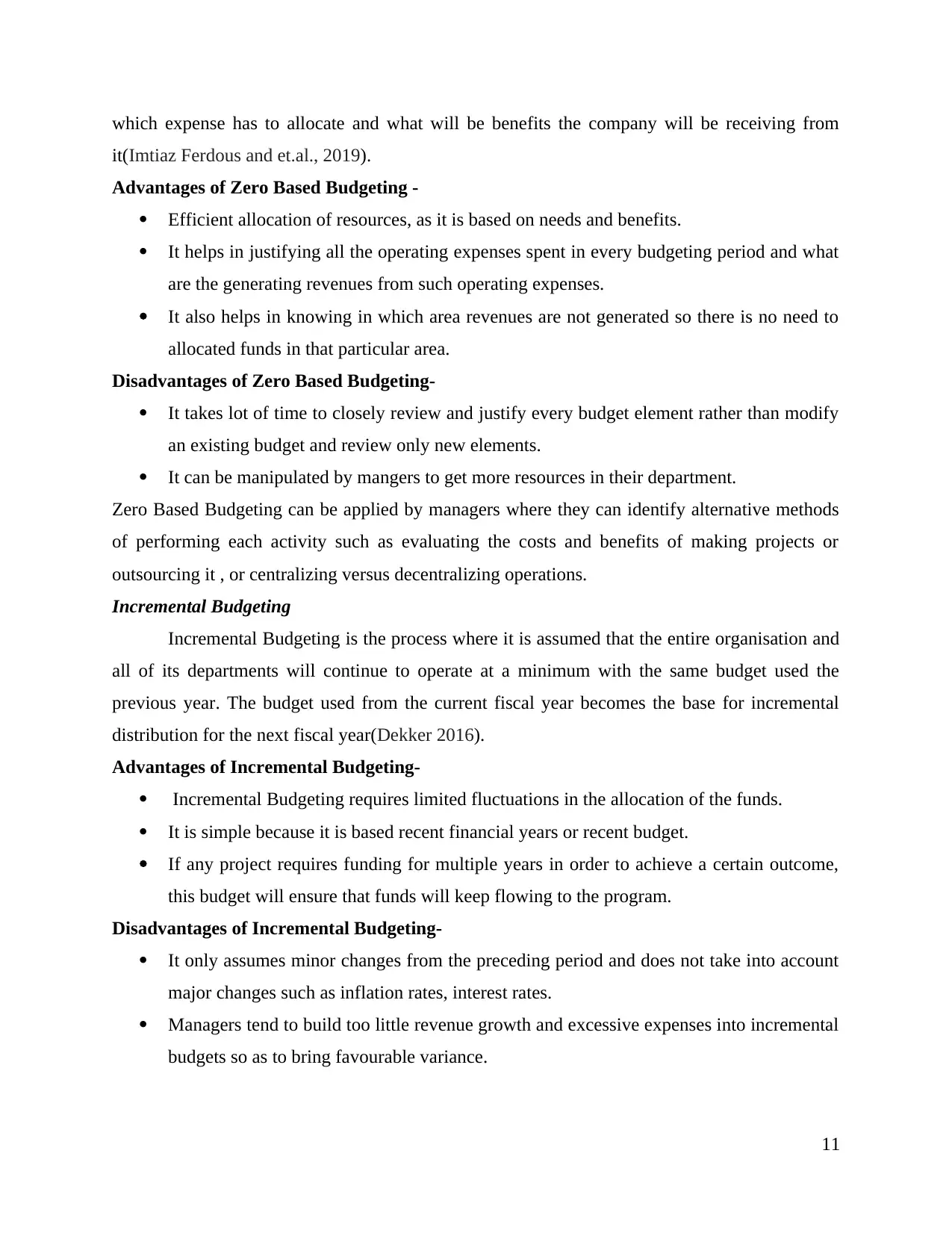
which expense has to allocate and what will be benefits the company will be receiving from
it(Imtiaz Ferdous and et.al., 2019).
Advantages of Zero Based Budgeting -
Efficient allocation of resources, as it is based on needs and benefits.
It helps in justifying all the operating expenses spent in every budgeting period and what
are the generating revenues from such operating expenses.
It also helps in knowing in which area revenues are not generated so there is no need to
allocated funds in that particular area.
Disadvantages of Zero Based Budgeting-
It takes lot of time to closely review and justify every budget element rather than modify
an existing budget and review only new elements.
It can be manipulated by mangers to get more resources in their department.
Zero Based Budgeting can be applied by managers where they can identify alternative methods
of performing each activity such as evaluating the costs and benefits of making projects or
outsourcing it , or centralizing versus decentralizing operations.
Incremental Budgeting
Incremental Budgeting is the process where it is assumed that the entire organisation and
all of its departments will continue to operate at a minimum with the same budget used the
previous year. The budget used from the current fiscal year becomes the base for incremental
distribution for the next fiscal year(Dekker 2016).
Advantages of Incremental Budgeting-
Incremental Budgeting requires limited fluctuations in the allocation of the funds.
It is simple because it is based recent financial years or recent budget.
If any project requires funding for multiple years in order to achieve a certain outcome,
this budget will ensure that funds will keep flowing to the program.
Disadvantages of Incremental Budgeting-
It only assumes minor changes from the preceding period and does not take into account
major changes such as inflation rates, interest rates.
Managers tend to build too little revenue growth and excessive expenses into incremental
budgets so as to bring favourable variance.
11
it(Imtiaz Ferdous and et.al., 2019).
Advantages of Zero Based Budgeting -
Efficient allocation of resources, as it is based on needs and benefits.
It helps in justifying all the operating expenses spent in every budgeting period and what
are the generating revenues from such operating expenses.
It also helps in knowing in which area revenues are not generated so there is no need to
allocated funds in that particular area.
Disadvantages of Zero Based Budgeting-
It takes lot of time to closely review and justify every budget element rather than modify
an existing budget and review only new elements.
It can be manipulated by mangers to get more resources in their department.
Zero Based Budgeting can be applied by managers where they can identify alternative methods
of performing each activity such as evaluating the costs and benefits of making projects or
outsourcing it , or centralizing versus decentralizing operations.
Incremental Budgeting
Incremental Budgeting is the process where it is assumed that the entire organisation and
all of its departments will continue to operate at a minimum with the same budget used the
previous year. The budget used from the current fiscal year becomes the base for incremental
distribution for the next fiscal year(Dekker 2016).
Advantages of Incremental Budgeting-
Incremental Budgeting requires limited fluctuations in the allocation of the funds.
It is simple because it is based recent financial years or recent budget.
If any project requires funding for multiple years in order to achieve a certain outcome,
this budget will ensure that funds will keep flowing to the program.
Disadvantages of Incremental Budgeting-
It only assumes minor changes from the preceding period and does not take into account
major changes such as inflation rates, interest rates.
Managers tend to build too little revenue growth and excessive expenses into incremental
budgets so as to bring favourable variance.
11
Paraphrase This Document
Need a fresh take? Get an instant paraphrase of this document with our AI Paraphraser
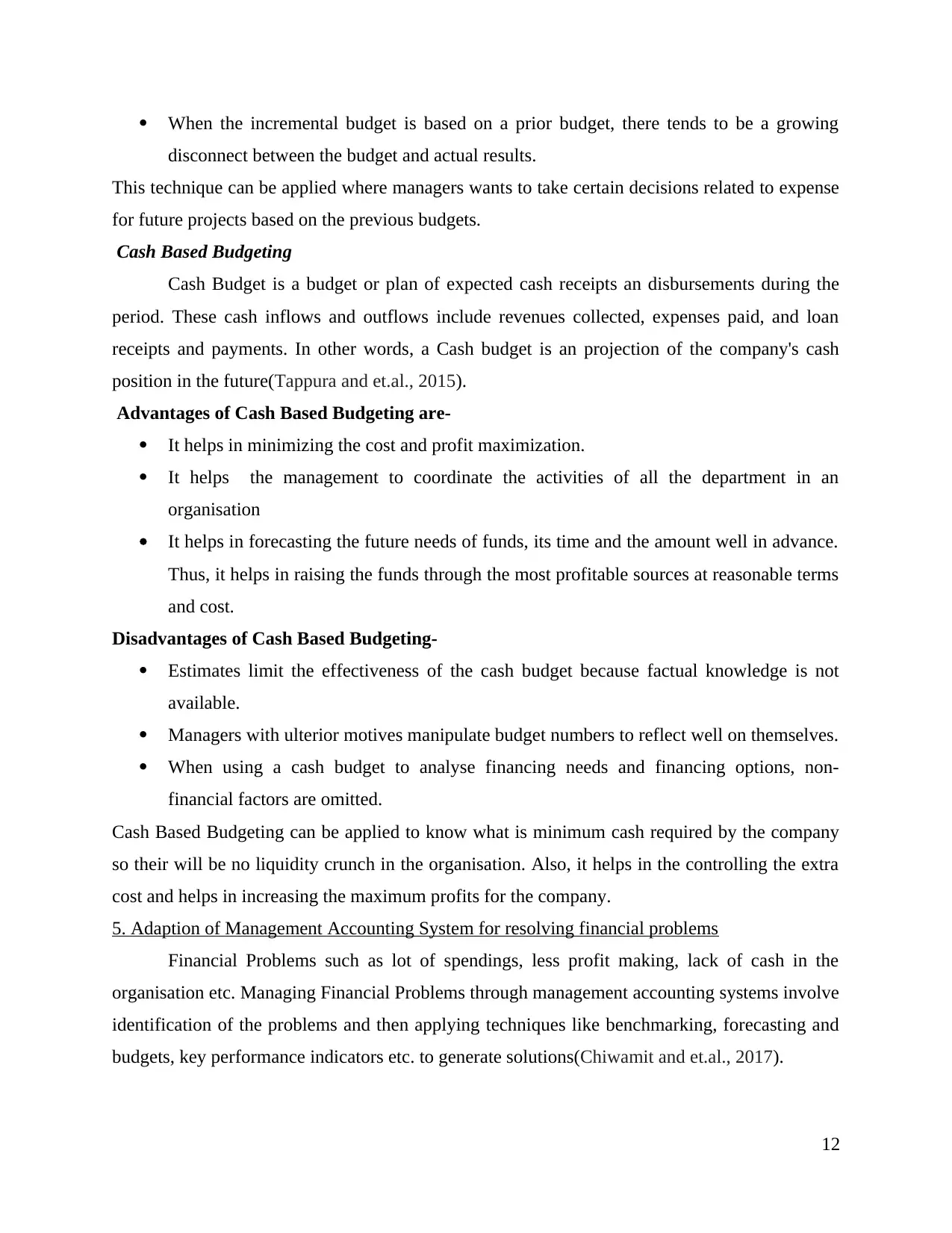
When the incremental budget is based on a prior budget, there tends to be a growing
disconnect between the budget and actual results.
This technique can be applied where managers wants to take certain decisions related to expense
for future projects based on the previous budgets.
Cash Based Budgeting
Cash Budget is a budget or plan of expected cash receipts an disbursements during the
period. These cash inflows and outflows include revenues collected, expenses paid, and loan
receipts and payments. In other words, a Cash budget is an projection of the company's cash
position in the future(Tappura and et.al., 2015).
Advantages of Cash Based Budgeting are-
It helps in minimizing the cost and profit maximization.
It helps the management to coordinate the activities of all the department in an
organisation
It helps in forecasting the future needs of funds, its time and the amount well in advance.
Thus, it helps in raising the funds through the most profitable sources at reasonable terms
and cost.
Disadvantages of Cash Based Budgeting-
Estimates limit the effectiveness of the cash budget because factual knowledge is not
available.
Managers with ulterior motives manipulate budget numbers to reflect well on themselves.
When using a cash budget to analyse financing needs and financing options, non-
financial factors are omitted.
Cash Based Budgeting can be applied to know what is minimum cash required by the company
so their will be no liquidity crunch in the organisation. Also, it helps in the controlling the extra
cost and helps in increasing the maximum profits for the company.
5. Adaption of Management Accounting System for resolving financial problems
Financial Problems such as lot of spendings, less profit making, lack of cash in the
organisation etc. Managing Financial Problems through management accounting systems involve
identification of the problems and then applying techniques like benchmarking, forecasting and
budgets, key performance indicators etc. to generate solutions(Chiwamit and et.al., 2017).
12
disconnect between the budget and actual results.
This technique can be applied where managers wants to take certain decisions related to expense
for future projects based on the previous budgets.
Cash Based Budgeting
Cash Budget is a budget or plan of expected cash receipts an disbursements during the
period. These cash inflows and outflows include revenues collected, expenses paid, and loan
receipts and payments. In other words, a Cash budget is an projection of the company's cash
position in the future(Tappura and et.al., 2015).
Advantages of Cash Based Budgeting are-
It helps in minimizing the cost and profit maximization.
It helps the management to coordinate the activities of all the department in an
organisation
It helps in forecasting the future needs of funds, its time and the amount well in advance.
Thus, it helps in raising the funds through the most profitable sources at reasonable terms
and cost.
Disadvantages of Cash Based Budgeting-
Estimates limit the effectiveness of the cash budget because factual knowledge is not
available.
Managers with ulterior motives manipulate budget numbers to reflect well on themselves.
When using a cash budget to analyse financing needs and financing options, non-
financial factors are omitted.
Cash Based Budgeting can be applied to know what is minimum cash required by the company
so their will be no liquidity crunch in the organisation. Also, it helps in the controlling the extra
cost and helps in increasing the maximum profits for the company.
5. Adaption of Management Accounting System for resolving financial problems
Financial Problems such as lot of spendings, less profit making, lack of cash in the
organisation etc. Managing Financial Problems through management accounting systems involve
identification of the problems and then applying techniques like benchmarking, forecasting and
budgets, key performance indicators etc. to generate solutions(Chiwamit and et.al., 2017).
12
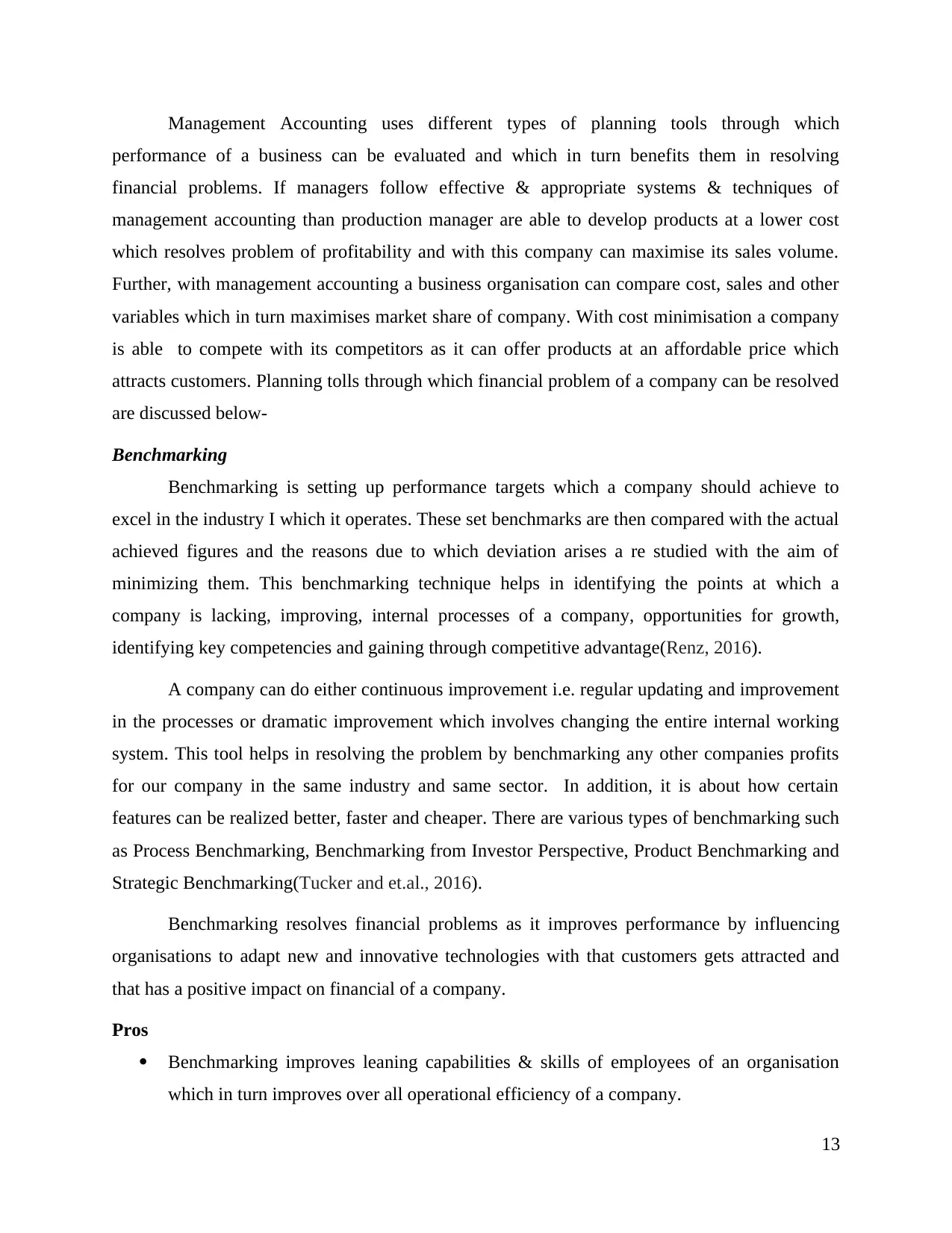
Management Accounting uses different types of planning tools through which
performance of a business can be evaluated and which in turn benefits them in resolving
financial problems. If managers follow effective & appropriate systems & techniques of
management accounting than production manager are able to develop products at a lower cost
which resolves problem of profitability and with this company can maximise its sales volume.
Further, with management accounting a business organisation can compare cost, sales and other
variables which in turn maximises market share of company. With cost minimisation a company
is able to compete with its competitors as it can offer products at an affordable price which
attracts customers. Planning tolls through which financial problem of a company can be resolved
are discussed below-
Benchmarking
Benchmarking is setting up performance targets which a company should achieve to
excel in the industry I which it operates. These set benchmarks are then compared with the actual
achieved figures and the reasons due to which deviation arises a re studied with the aim of
minimizing them. This benchmarking technique helps in identifying the points at which a
company is lacking, improving, internal processes of a company, opportunities for growth,
identifying key competencies and gaining through competitive advantage(Renz, 2016).
A company can do either continuous improvement i.e. regular updating and improvement
in the processes or dramatic improvement which involves changing the entire internal working
system. This tool helps in resolving the problem by benchmarking any other companies profits
for our company in the same industry and same sector. In addition, it is about how certain
features can be realized better, faster and cheaper. There are various types of benchmarking such
as Process Benchmarking, Benchmarking from Investor Perspective, Product Benchmarking and
Strategic Benchmarking(Tucker and et.al., 2016).
Benchmarking resolves financial problems as it improves performance by influencing
organisations to adapt new and innovative technologies with that customers gets attracted and
that has a positive impact on financial of a company.
Pros
Benchmarking improves leaning capabilities & skills of employees of an organisation
which in turn improves over all operational efficiency of a company.
13
performance of a business can be evaluated and which in turn benefits them in resolving
financial problems. If managers follow effective & appropriate systems & techniques of
management accounting than production manager are able to develop products at a lower cost
which resolves problem of profitability and with this company can maximise its sales volume.
Further, with management accounting a business organisation can compare cost, sales and other
variables which in turn maximises market share of company. With cost minimisation a company
is able to compete with its competitors as it can offer products at an affordable price which
attracts customers. Planning tolls through which financial problem of a company can be resolved
are discussed below-
Benchmarking
Benchmarking is setting up performance targets which a company should achieve to
excel in the industry I which it operates. These set benchmarks are then compared with the actual
achieved figures and the reasons due to which deviation arises a re studied with the aim of
minimizing them. This benchmarking technique helps in identifying the points at which a
company is lacking, improving, internal processes of a company, opportunities for growth,
identifying key competencies and gaining through competitive advantage(Renz, 2016).
A company can do either continuous improvement i.e. regular updating and improvement
in the processes or dramatic improvement which involves changing the entire internal working
system. This tool helps in resolving the problem by benchmarking any other companies profits
for our company in the same industry and same sector. In addition, it is about how certain
features can be realized better, faster and cheaper. There are various types of benchmarking such
as Process Benchmarking, Benchmarking from Investor Perspective, Product Benchmarking and
Strategic Benchmarking(Tucker and et.al., 2016).
Benchmarking resolves financial problems as it improves performance by influencing
organisations to adapt new and innovative technologies with that customers gets attracted and
that has a positive impact on financial of a company.
Pros
Benchmarking improves leaning capabilities & skills of employees of an organisation
which in turn improves over all operational efficiency of a company.
13
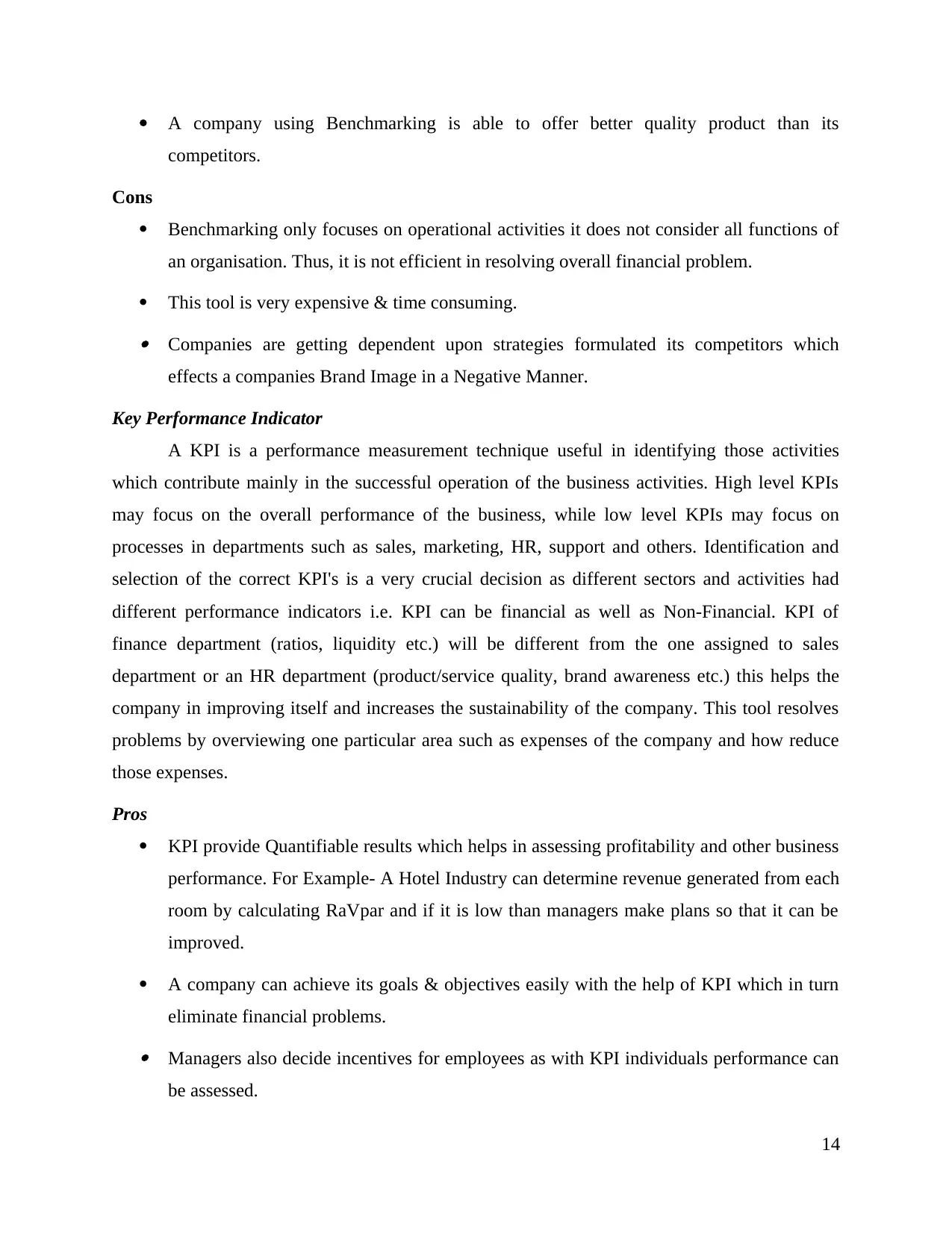
A company using Benchmarking is able to offer better quality product than its
competitors.
Cons
Benchmarking only focuses on operational activities it does not consider all functions of
an organisation. Thus, it is not efficient in resolving overall financial problem.
This tool is very expensive & time consuming. Companies are getting dependent upon strategies formulated its competitors which
effects a companies Brand Image in a Negative Manner.
Key Performance Indicator
A KPI is a performance measurement technique useful in identifying those activities
which contribute mainly in the successful operation of the business activities. High level KPIs
may focus on the overall performance of the business, while low level KPIs may focus on
processes in departments such as sales, marketing, HR, support and others. Identification and
selection of the correct KPI's is a very crucial decision as different sectors and activities had
different performance indicators i.e. KPI can be financial as well as Non-Financial. KPI of
finance department (ratios, liquidity etc.) will be different from the one assigned to sales
department or an HR department (product/service quality, brand awareness etc.) this helps the
company in improving itself and increases the sustainability of the company. This tool resolves
problems by overviewing one particular area such as expenses of the company and how reduce
those expenses.
Pros
KPI provide Quantifiable results which helps in assessing profitability and other business
performance. For Example- A Hotel Industry can determine revenue generated from each
room by calculating RaVpar and if it is low than managers make plans so that it can be
improved.
A company can achieve its goals & objectives easily with the help of KPI which in turn
eliminate financial problems. Managers also decide incentives for employees as with KPI individuals performance can
be assessed.
14
competitors.
Cons
Benchmarking only focuses on operational activities it does not consider all functions of
an organisation. Thus, it is not efficient in resolving overall financial problem.
This tool is very expensive & time consuming. Companies are getting dependent upon strategies formulated its competitors which
effects a companies Brand Image in a Negative Manner.
Key Performance Indicator
A KPI is a performance measurement technique useful in identifying those activities
which contribute mainly in the successful operation of the business activities. High level KPIs
may focus on the overall performance of the business, while low level KPIs may focus on
processes in departments such as sales, marketing, HR, support and others. Identification and
selection of the correct KPI's is a very crucial decision as different sectors and activities had
different performance indicators i.e. KPI can be financial as well as Non-Financial. KPI of
finance department (ratios, liquidity etc.) will be different from the one assigned to sales
department or an HR department (product/service quality, brand awareness etc.) this helps the
company in improving itself and increases the sustainability of the company. This tool resolves
problems by overviewing one particular area such as expenses of the company and how reduce
those expenses.
Pros
KPI provide Quantifiable results which helps in assessing profitability and other business
performance. For Example- A Hotel Industry can determine revenue generated from each
room by calculating RaVpar and if it is low than managers make plans so that it can be
improved.
A company can achieve its goals & objectives easily with the help of KPI which in turn
eliminate financial problems. Managers also decide incentives for employees as with KPI individuals performance can
be assessed.
14
Secure Best Marks with AI Grader
Need help grading? Try our AI Grader for instant feedback on your assignments.
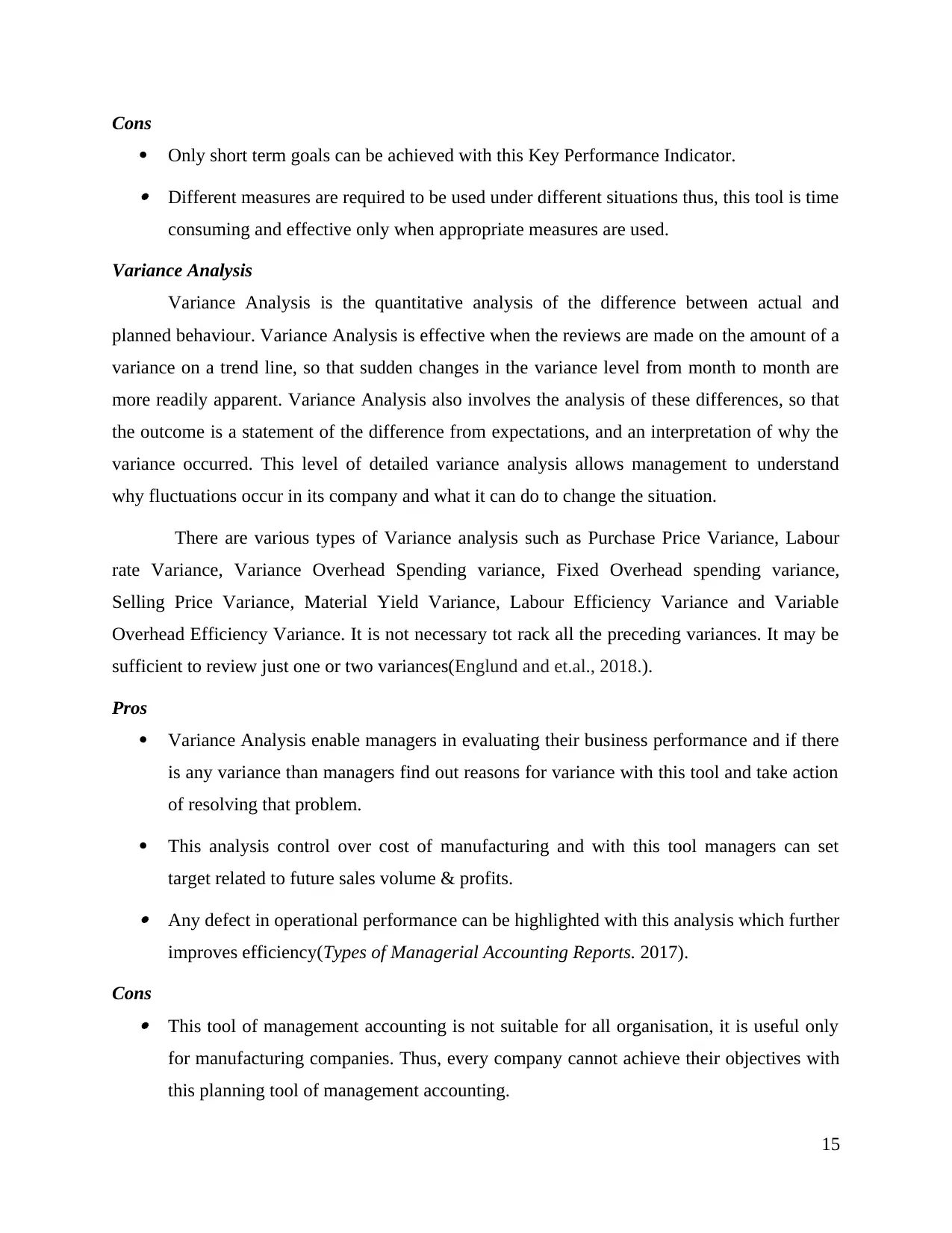
Cons
Only short term goals can be achieved with this Key Performance Indicator. Different measures are required to be used under different situations thus, this tool is time
consuming and effective only when appropriate measures are used.
Variance Analysis
Variance Analysis is the quantitative analysis of the difference between actual and
planned behaviour. Variance Analysis is effective when the reviews are made on the amount of a
variance on a trend line, so that sudden changes in the variance level from month to month are
more readily apparent. Variance Analysis also involves the analysis of these differences, so that
the outcome is a statement of the difference from expectations, and an interpretation of why the
variance occurred. This level of detailed variance analysis allows management to understand
why fluctuations occur in its company and what it can do to change the situation.
There are various types of Variance analysis such as Purchase Price Variance, Labour
rate Variance, Variance Overhead Spending variance, Fixed Overhead spending variance,
Selling Price Variance, Material Yield Variance, Labour Efficiency Variance and Variable
Overhead Efficiency Variance. It is not necessary tot rack all the preceding variances. It may be
sufficient to review just one or two variances(Englund and et.al., 2018.).
Pros
Variance Analysis enable managers in evaluating their business performance and if there
is any variance than managers find out reasons for variance with this tool and take action
of resolving that problem.
This analysis control over cost of manufacturing and with this tool managers can set
target related to future sales volume & profits. Any defect in operational performance can be highlighted with this analysis which further
improves efficiency(Types of Managerial Accounting Reports. 2017).
Cons This tool of management accounting is not suitable for all organisation, it is useful only
for manufacturing companies. Thus, every company cannot achieve their objectives with
this planning tool of management accounting.
15
Only short term goals can be achieved with this Key Performance Indicator. Different measures are required to be used under different situations thus, this tool is time
consuming and effective only when appropriate measures are used.
Variance Analysis
Variance Analysis is the quantitative analysis of the difference between actual and
planned behaviour. Variance Analysis is effective when the reviews are made on the amount of a
variance on a trend line, so that sudden changes in the variance level from month to month are
more readily apparent. Variance Analysis also involves the analysis of these differences, so that
the outcome is a statement of the difference from expectations, and an interpretation of why the
variance occurred. This level of detailed variance analysis allows management to understand
why fluctuations occur in its company and what it can do to change the situation.
There are various types of Variance analysis such as Purchase Price Variance, Labour
rate Variance, Variance Overhead Spending variance, Fixed Overhead spending variance,
Selling Price Variance, Material Yield Variance, Labour Efficiency Variance and Variable
Overhead Efficiency Variance. It is not necessary tot rack all the preceding variances. It may be
sufficient to review just one or two variances(Englund and et.al., 2018.).
Pros
Variance Analysis enable managers in evaluating their business performance and if there
is any variance than managers find out reasons for variance with this tool and take action
of resolving that problem.
This analysis control over cost of manufacturing and with this tool managers can set
target related to future sales volume & profits. Any defect in operational performance can be highlighted with this analysis which further
improves efficiency(Types of Managerial Accounting Reports. 2017).
Cons This tool of management accounting is not suitable for all organisation, it is useful only
for manufacturing companies. Thus, every company cannot achieve their objectives with
this planning tool of management accounting.
15
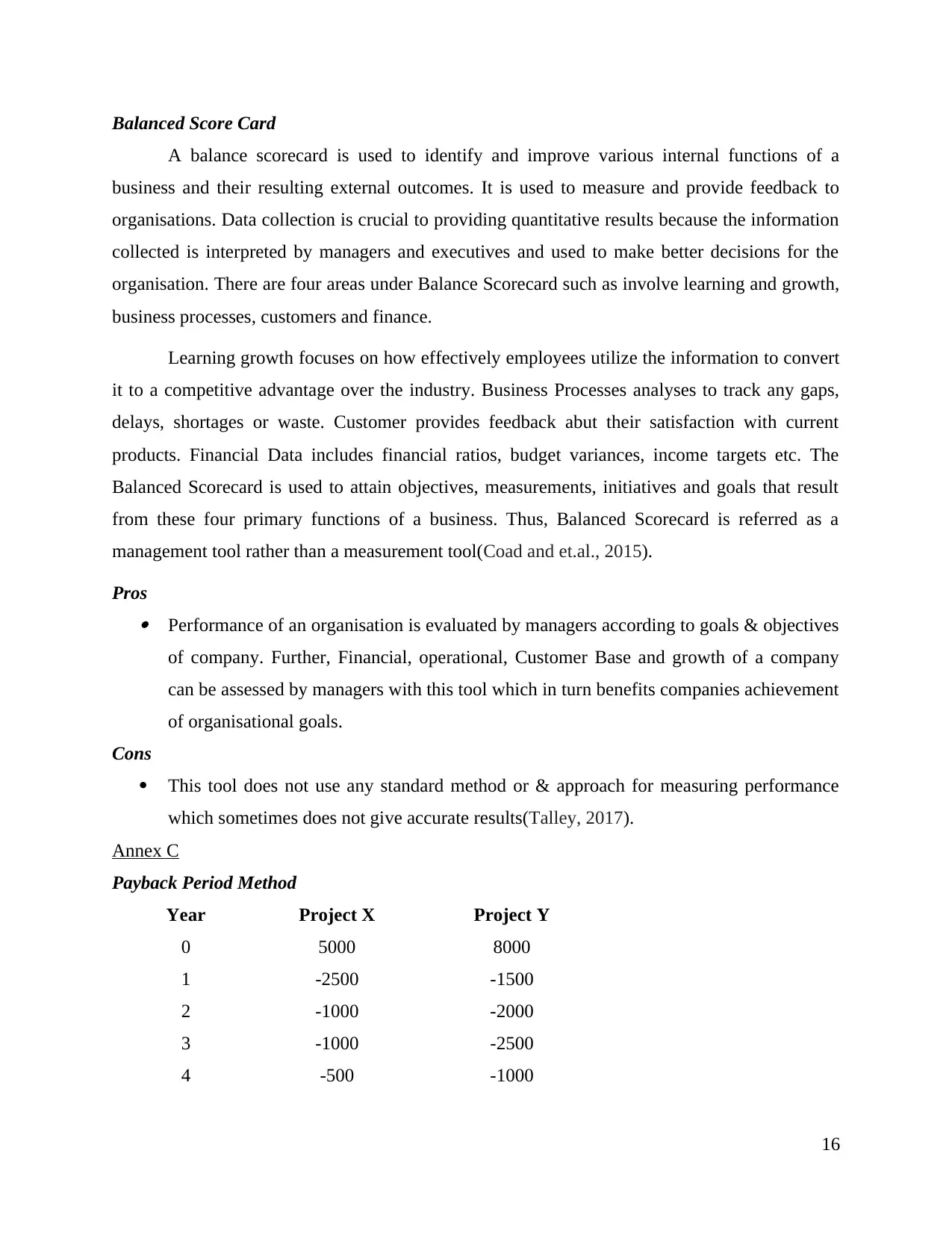
Balanced Score Card
A balance scorecard is used to identify and improve various internal functions of a
business and their resulting external outcomes. It is used to measure and provide feedback to
organisations. Data collection is crucial to providing quantitative results because the information
collected is interpreted by managers and executives and used to make better decisions for the
organisation. There are four areas under Balance Scorecard such as involve learning and growth,
business processes, customers and finance.
Learning growth focuses on how effectively employees utilize the information to convert
it to a competitive advantage over the industry. Business Processes analyses to track any gaps,
delays, shortages or waste. Customer provides feedback abut their satisfaction with current
products. Financial Data includes financial ratios, budget variances, income targets etc. The
Balanced Scorecard is used to attain objectives, measurements, initiatives and goals that result
from these four primary functions of a business. Thus, Balanced Scorecard is referred as a
management tool rather than a measurement tool(Coad and et.al., 2015).
Pros Performance of an organisation is evaluated by managers according to goals & objectives
of company. Further, Financial, operational, Customer Base and growth of a company
can be assessed by managers with this tool which in turn benefits companies achievement
of organisational goals.
Cons
This tool does not use any standard method or & approach for measuring performance
which sometimes does not give accurate results(Talley, 2017).
Annex C
Payback Period Method
Year Project X Project Y
0 5000 8000
1 -2500 -1500
2 -1000 -2000
3 -1000 -2500
4 -500 -1000
16
A balance scorecard is used to identify and improve various internal functions of a
business and their resulting external outcomes. It is used to measure and provide feedback to
organisations. Data collection is crucial to providing quantitative results because the information
collected is interpreted by managers and executives and used to make better decisions for the
organisation. There are four areas under Balance Scorecard such as involve learning and growth,
business processes, customers and finance.
Learning growth focuses on how effectively employees utilize the information to convert
it to a competitive advantage over the industry. Business Processes analyses to track any gaps,
delays, shortages or waste. Customer provides feedback abut their satisfaction with current
products. Financial Data includes financial ratios, budget variances, income targets etc. The
Balanced Scorecard is used to attain objectives, measurements, initiatives and goals that result
from these four primary functions of a business. Thus, Balanced Scorecard is referred as a
management tool rather than a measurement tool(Coad and et.al., 2015).
Pros Performance of an organisation is evaluated by managers according to goals & objectives
of company. Further, Financial, operational, Customer Base and growth of a company
can be assessed by managers with this tool which in turn benefits companies achievement
of organisational goals.
Cons
This tool does not use any standard method or & approach for measuring performance
which sometimes does not give accurate results(Talley, 2017).
Annex C
Payback Period Method
Year Project X Project Y
0 5000 8000
1 -2500 -1500
2 -1000 -2000
3 -1000 -2500
4 -500 -1000
16
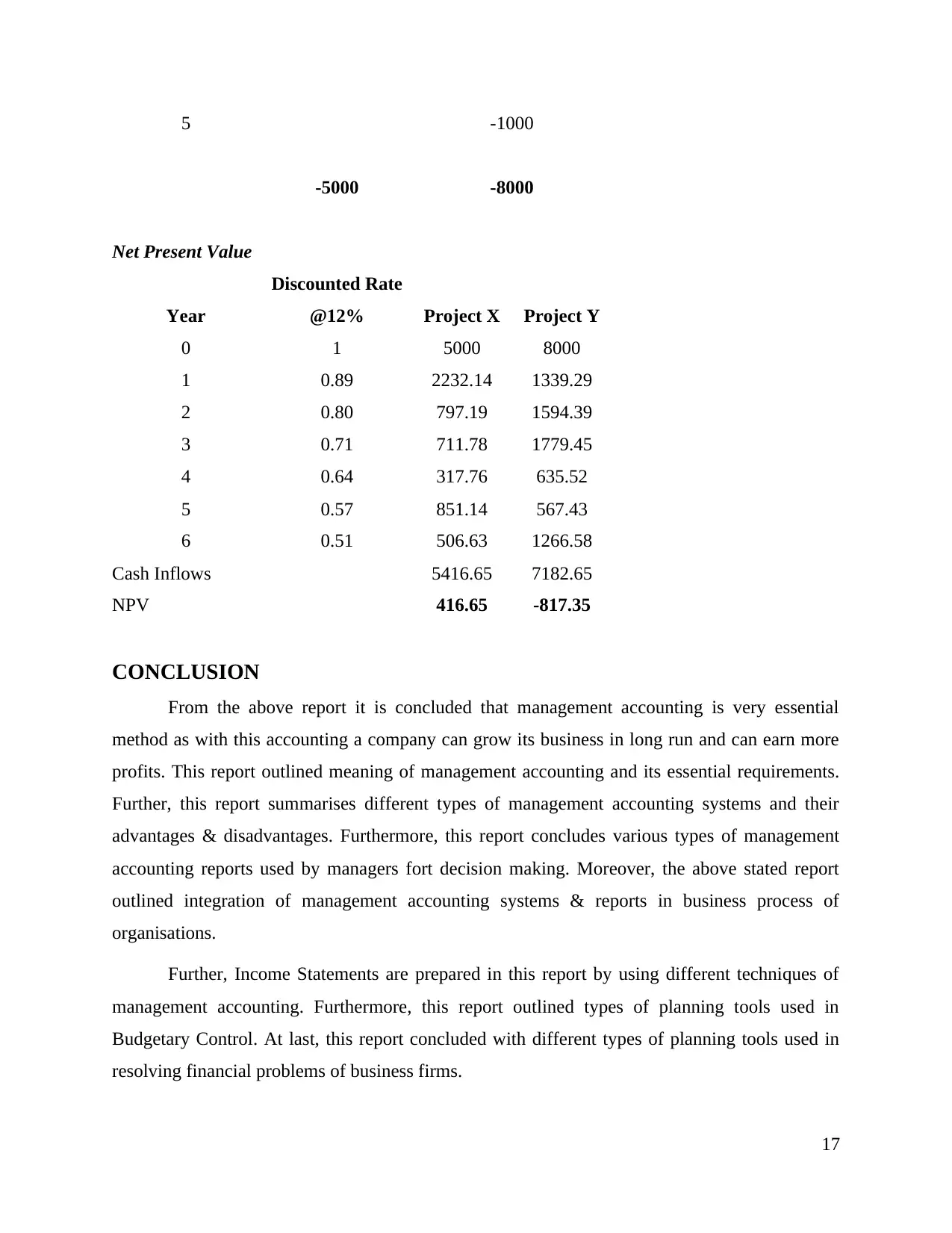
5 -1000
-5000 -8000
Net Present Value
Year
Discounted Rate
@12% Project X Project Y
0 1 5000 8000
1 0.89 2232.14 1339.29
2 0.80 797.19 1594.39
3 0.71 711.78 1779.45
4 0.64 317.76 635.52
5 0.57 851.14 567.43
6 0.51 506.63 1266.58
Cash Inflows 5416.65 7182.65
NPV 416.65 -817.35
CONCLUSION
From the above report it is concluded that management accounting is very essential
method as with this accounting a company can grow its business in long run and can earn more
profits. This report outlined meaning of management accounting and its essential requirements.
Further, this report summarises different types of management accounting systems and their
advantages & disadvantages. Furthermore, this report concludes various types of management
accounting reports used by managers fort decision making. Moreover, the above stated report
outlined integration of management accounting systems & reports in business process of
organisations.
Further, Income Statements are prepared in this report by using different techniques of
management accounting. Furthermore, this report outlined types of planning tools used in
Budgetary Control. At last, this report concluded with different types of planning tools used in
resolving financial problems of business firms.
17
-5000 -8000
Net Present Value
Year
Discounted Rate
@12% Project X Project Y
0 1 5000 8000
1 0.89 2232.14 1339.29
2 0.80 797.19 1594.39
3 0.71 711.78 1779.45
4 0.64 317.76 635.52
5 0.57 851.14 567.43
6 0.51 506.63 1266.58
Cash Inflows 5416.65 7182.65
NPV 416.65 -817.35
CONCLUSION
From the above report it is concluded that management accounting is very essential
method as with this accounting a company can grow its business in long run and can earn more
profits. This report outlined meaning of management accounting and its essential requirements.
Further, this report summarises different types of management accounting systems and their
advantages & disadvantages. Furthermore, this report concludes various types of management
accounting reports used by managers fort decision making. Moreover, the above stated report
outlined integration of management accounting systems & reports in business process of
organisations.
Further, Income Statements are prepared in this report by using different techniques of
management accounting. Furthermore, this report outlined types of planning tools used in
Budgetary Control. At last, this report concluded with different types of planning tools used in
resolving financial problems of business firms.
17
Paraphrase This Document
Need a fresh take? Get an instant paraphrase of this document with our AI Paraphraser
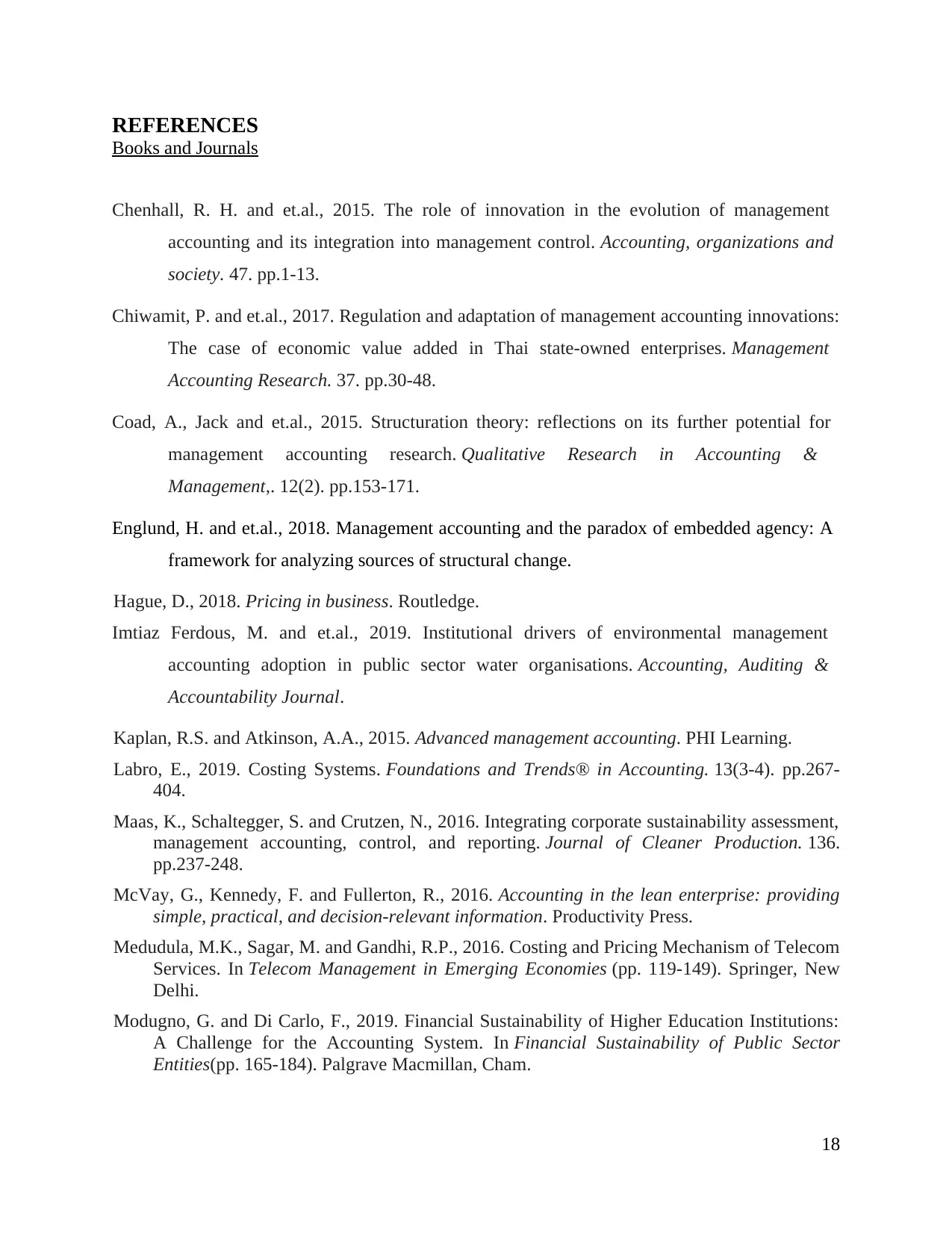
REFERENCES
Books and Journals
Chenhall, R. H. and et.al., 2015. The role of innovation in the evolution of management
accounting and its integration into management control. Accounting, organizations and
society. 47. pp.1-13.
Chiwamit, P. and et.al., 2017. Regulation and adaptation of management accounting innovations:
The case of economic value added in Thai state-owned enterprises. Management
Accounting Research. 37. pp.30-48.
Coad, A., Jack and et.al., 2015. Structuration theory: reflections on its further potential for
management accounting research. Qualitative Research in Accounting &
Management,. 12(2). pp.153-171.
Englund, H. and et.al., 2018. Management accounting and the paradox of embedded agency: A
framework for analyzing sources of structural change.
Hague, D., 2018. Pricing in business. Routledge.
Imtiaz Ferdous, M. and et.al., 2019. Institutional drivers of environmental management
accounting adoption in public sector water organisations. Accounting, Auditing &
Accountability Journal.
Kaplan, R.S. and Atkinson, A.A., 2015. Advanced management accounting. PHI Learning.
Labro, E., 2019. Costing Systems. Foundations and Trends® in Accounting. 13(3-4). pp.267-
404.
Maas, K., Schaltegger, S. and Crutzen, N., 2016. Integrating corporate sustainability assessment,
management accounting, control, and reporting. Journal of Cleaner Production. 136.
pp.237-248.
McVay, G., Kennedy, F. and Fullerton, R., 2016. Accounting in the lean enterprise: providing
simple, practical, and decision-relevant information. Productivity Press.
Medudula, M.K., Sagar, M. and Gandhi, R.P., 2016. Costing and Pricing Mechanism of Telecom
Services. In Telecom Management in Emerging Economies (pp. 119-149). Springer, New
Delhi.
Modugno, G. and Di Carlo, F., 2019. Financial Sustainability of Higher Education Institutions:
A Challenge for the Accounting System. In Financial Sustainability of Public Sector
Entities(pp. 165-184). Palgrave Macmillan, Cham.
18
Books and Journals
Chenhall, R. H. and et.al., 2015. The role of innovation in the evolution of management
accounting and its integration into management control. Accounting, organizations and
society. 47. pp.1-13.
Chiwamit, P. and et.al., 2017. Regulation and adaptation of management accounting innovations:
The case of economic value added in Thai state-owned enterprises. Management
Accounting Research. 37. pp.30-48.
Coad, A., Jack and et.al., 2015. Structuration theory: reflections on its further potential for
management accounting research. Qualitative Research in Accounting &
Management,. 12(2). pp.153-171.
Englund, H. and et.al., 2018. Management accounting and the paradox of embedded agency: A
framework for analyzing sources of structural change.
Hague, D., 2018. Pricing in business. Routledge.
Imtiaz Ferdous, M. and et.al., 2019. Institutional drivers of environmental management
accounting adoption in public sector water organisations. Accounting, Auditing &
Accountability Journal.
Kaplan, R.S. and Atkinson, A.A., 2015. Advanced management accounting. PHI Learning.
Labro, E., 2019. Costing Systems. Foundations and Trends® in Accounting. 13(3-4). pp.267-
404.
Maas, K., Schaltegger, S. and Crutzen, N., 2016. Integrating corporate sustainability assessment,
management accounting, control, and reporting. Journal of Cleaner Production. 136.
pp.237-248.
McVay, G., Kennedy, F. and Fullerton, R., 2016. Accounting in the lean enterprise: providing
simple, practical, and decision-relevant information. Productivity Press.
Medudula, M.K., Sagar, M. and Gandhi, R.P., 2016. Costing and Pricing Mechanism of Telecom
Services. In Telecom Management in Emerging Economies (pp. 119-149). Springer, New
Delhi.
Modugno, G. and Di Carlo, F., 2019. Financial Sustainability of Higher Education Institutions:
A Challenge for the Accounting System. In Financial Sustainability of Public Sector
Entities(pp. 165-184). Palgrave Macmillan, Cham.
18
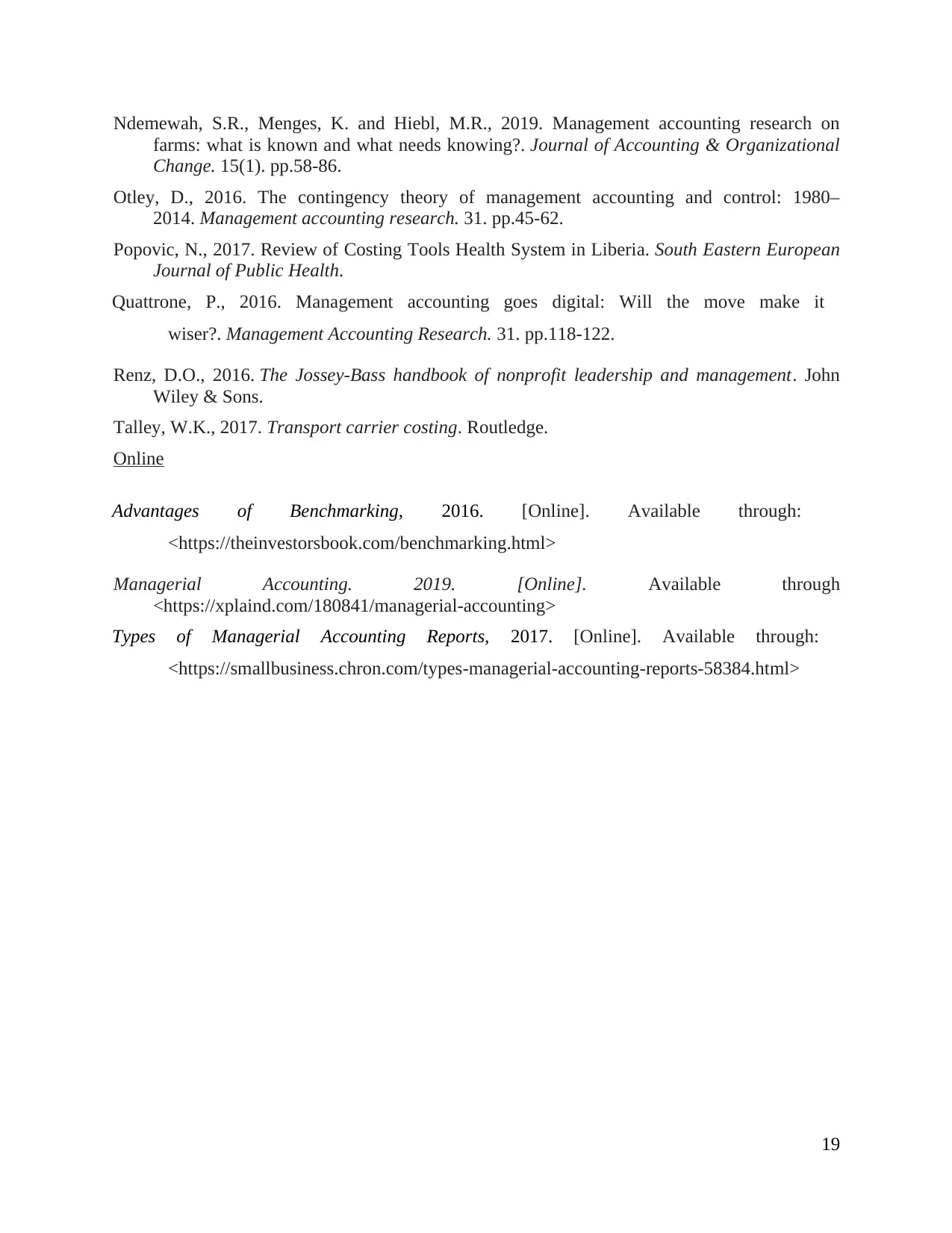
Ndemewah, S.R., Menges, K. and Hiebl, M.R., 2019. Management accounting research on
farms: what is known and what needs knowing?. Journal of Accounting & Organizational
Change. 15(1). pp.58-86.
Otley, D., 2016. The contingency theory of management accounting and control: 1980–
2014. Management accounting research. 31. pp.45-62.
Popovic, N., 2017. Review of Costing Tools Health System in Liberia. South Eastern European
Journal of Public Health.
Quattrone, P., 2016. Management accounting goes digital: Will the move make it
wiser?. Management Accounting Research. 31. pp.118-122.
Renz, D.O., 2016. The Jossey-Bass handbook of nonprofit leadership and management. John
Wiley & Sons.
Talley, W.K., 2017. Transport carrier costing. Routledge.
Online
Advantages of Benchmarking, 2016. [Online]. Available through:
<https://theinvestorsbook.com/benchmarking.html>
Managerial Accounting. 2019. [Online]. Available through
<https://xplaind.com/180841/managerial-accounting>
Types of Managerial Accounting Reports, 2017. [Online]. Available through:
<https://smallbusiness.chron.com/types-managerial-accounting-reports-58384.html>
19
farms: what is known and what needs knowing?. Journal of Accounting & Organizational
Change. 15(1). pp.58-86.
Otley, D., 2016. The contingency theory of management accounting and control: 1980–
2014. Management accounting research. 31. pp.45-62.
Popovic, N., 2017. Review of Costing Tools Health System in Liberia. South Eastern European
Journal of Public Health.
Quattrone, P., 2016. Management accounting goes digital: Will the move make it
wiser?. Management Accounting Research. 31. pp.118-122.
Renz, D.O., 2016. The Jossey-Bass handbook of nonprofit leadership and management. John
Wiley & Sons.
Talley, W.K., 2017. Transport carrier costing. Routledge.
Online
Advantages of Benchmarking, 2016. [Online]. Available through:
<https://theinvestorsbook.com/benchmarking.html>
Managerial Accounting. 2019. [Online]. Available through
<https://xplaind.com/180841/managerial-accounting>
Types of Managerial Accounting Reports, 2017. [Online]. Available through:
<https://smallbusiness.chron.com/types-managerial-accounting-reports-58384.html>
19
1 out of 21
Related Documents
Your All-in-One AI-Powered Toolkit for Academic Success.
+13062052269
info@desklib.com
Available 24*7 on WhatsApp / Email
![[object Object]](/_next/static/media/star-bottom.7253800d.svg)
Unlock your academic potential
© 2024 | Zucol Services PVT LTD | All rights reserved.





